20. MIDDLE AMERICA COMES OF AGE

SHIFTS IN THE AMERICAN CULTURE
CONTENTS
 Tensions between "Middle America" and Tensions between "Middle America" and
"Intellectual America" heighten
 Eisenhower takes command Eisenhower takes command
 McCarthy is finally brought down McCarthy is finally brought down
 Middle America settles in ... quite Middle America settles in ... quite
spectacularly!
 But a "Boomer" youth culture quite But a "Boomer" youth culture quite
distinct from Middle America is
developing
 And the Vets have their own particular And the Vets have their own particular
form of Idealism
 The "Silent" or in-between generation The "Silent" or in-between generation
 Tragically, Black America does not share Tragically, Black America does not share
Middle America's culture
 Happily, it's also a time for some "firsts" Happily, it's also a time for some "firsts"
The textual material on this webpage is drawn directly from my work
America – The Covenant Nation © 2021, Volume Two, pages 106-119.
CULTURAL TENSIONS BETWEEN "MIDDLE AMERICA" AND INTELLECTUAL AMERICA" HEIGHTEN IN THE 50s |
|
While the Korean War was well underway, an
accusatory voice in the U.S. Senate became even louder. While HUAC over
on the House side of Congress was conducting wide-reaching
investigations into spying going on within Intellectual America,
Wisconsin Senator Joseph McCarthy was busy on the Senate side holding
investigations into spying within the American government itself.
Based on HUAC's discovery of Hiss's
treasonous spying, McCarthy took the lead in accusing (without any
specific details) even more broadly the American diplomatic corps, then
the American civilian government in general, and then finally, by 1954,
even the US military, of being loaded with Communists ... Communists
everywhere, Communists who were secretly subverting America.
This intense Red Scare (both McCarthy's
and HUAC's) hit especially hard against not only America's civilian and
military authorities but also the country's cultural elite and
intellectuals, many of whom had long been suspected of harboring
Communist sympathies. Many authors, playwrights, journalists,
professors, etc., had held (since the 1930s) fancy ideas about the need
for social reform – ideas which seemed overly critical, even
unpatriotic, even treasonous, to the fiercely patriotic Middle-Class
World-War-Two Vets.
These Vets therefore were easily led to
believe that this class of intellectuals formed a conspiratorial group
seeking to overthrow the nation and everything it stood for. Needless
to say, the intellectuals did all that they could do to fight back –
though it had to be done cautiously ... very cautiously.
One of the tragic consequences of this
Red Scare and the focus in particular on cultural leaders with their
"unusual" or unorthodox views was the bitter disaffection from a sense
of national patriotism on the part of a good number of American
intellectuals.
Thus it was that a "high-brow"
Intellectual and a "low-brow" Middle-Class Vet divide grew deep within
America. From film artists in Hollywood to university professors in the
hallowed halls of academia, to writers and journalists, there developed
a deep sense of distancing from the fervent anti-Communist patriotism
found strongly within the heart of Middle America.
A deep wound of alienation would fester
among these cultural leaders until the pain had a chance to express
itself in the turbulent 1960s when America fell into serious cultural
civil war. The revenge sought at that time by the alienated cultural
elite would add tremendously to the cultural tensions of the times.
Arthur Miller's play, The Crucible
A classic example was that of the
playwright Arthur Miller. Miller’s close friend Elia Kazan in 1952 had
yielded before the House Un-American Activities Committee and named
eight members of his Group Theater as having been fellow members of the
Communist Party. Miller was so shocked and depressed by this act of
betrayal on the part of his friend that he researched an almost
forgotten event in American history, the Salem witch trials of
1692–1693, and wrote the 1953 play The Crucible
– using this event as a not-too-subtle allusion to the Communist witch
hunt going on around him in the early 1950s. The challenge to the Cold
War culture was obvious, and the play immediately deepened the
suspicion of the House Un-American Activities Committee about Miller.
It is important to note that the play did
not do very well in the 1950s. But when the national mood changed
(drastically) in the 1960s, it was brought back to public notice, and
then became a major success – so much so that during (and since) the
1960s, Miller’s play became the rising intellectual New Left’s standard
view not only of 17th century Puritanism but also of 20th century
Christian America. Indeed the play soon became required reading in many
high school American-literature courses across the country, helping to
turn young Americans away from their nation’s cultural roots founded
deeply in Christianity.
|
There to exploit the nation's
fears for his own political advancement is an otherwise non-descript Senator from Wisconsin, Joseph
McCarthy
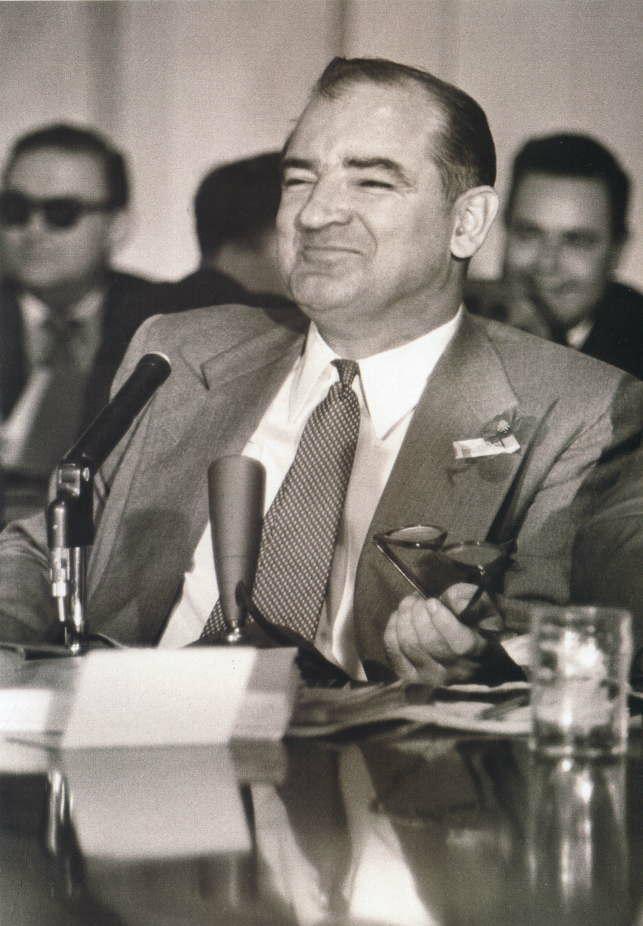 Joseph McCarthy – Junior
Senator from Wisconsin
Joseph McCarthy – Junior
Senator from Wisconsin
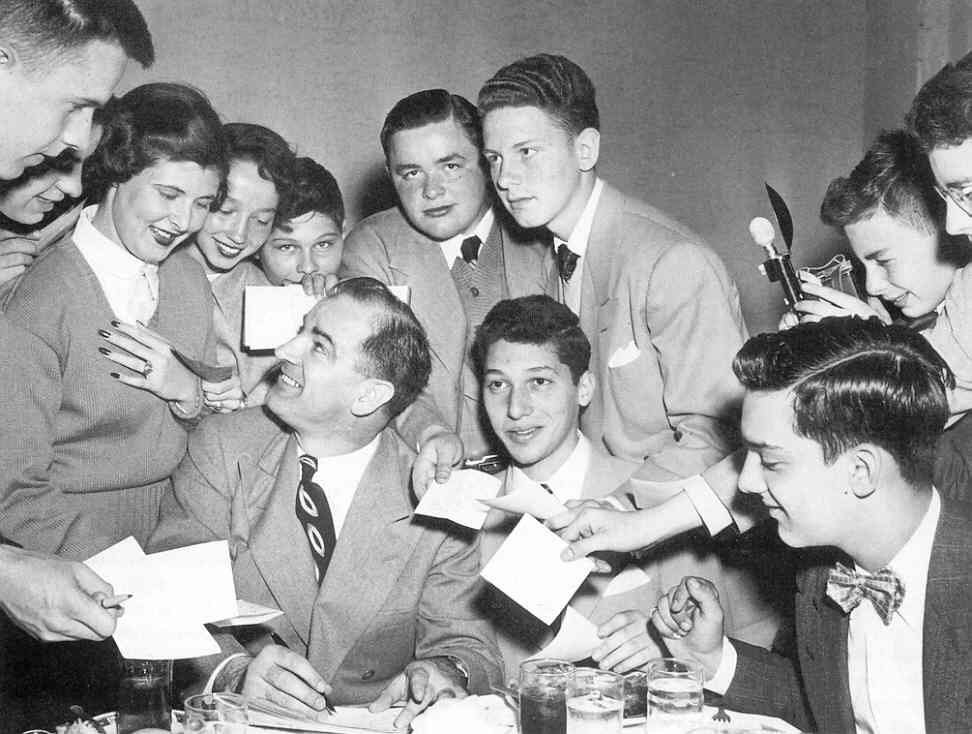
Sen. Joseph R. McCarthy signing
autographs for students – 1950
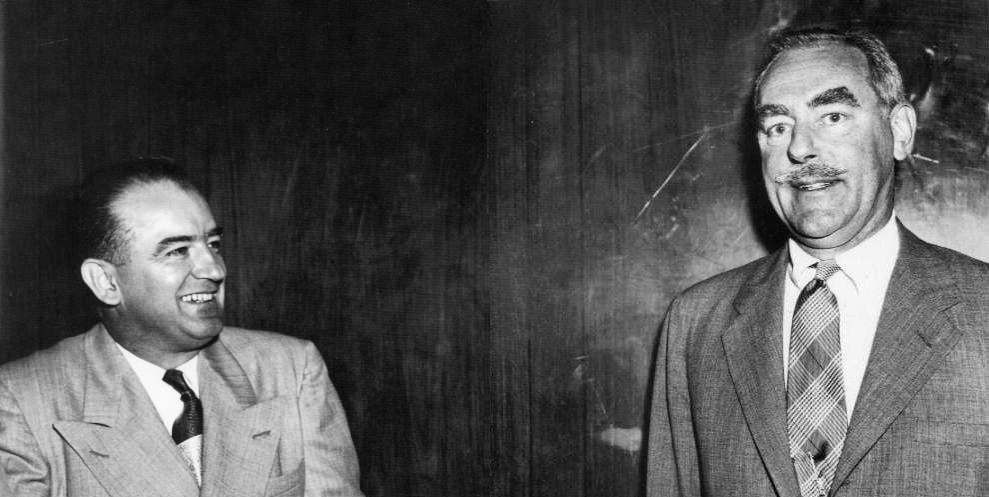
Sen. Joe McCarthy smiling – with Dean Acheson in a very uncomfortable moment in a Senate elevator (McCarthy failed to understand
the reaction of others to his ill-founded and highly destructive smears)
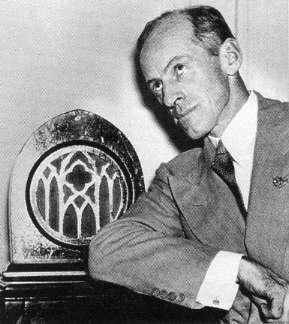 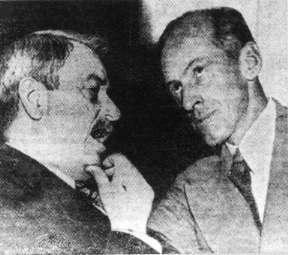
A photo doctored by a McCarthy
aide (later his wife) to make a McCarthy enemy, Maryland Sen. Millard Tydings, appear
to be listening to the U.S. Communist leader Earl Browder; it was distributed in a
successful effort to lose Tydings his re-election race in 1952
 McCarthy listening to two
aides, Roy Cohn (left) and Don Surine (right)
McCarthy listening to two
aides, Roy Cohn (left) and Don Surine (right)
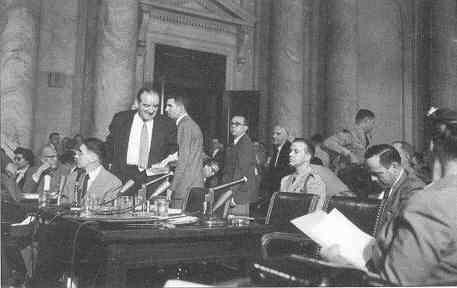 The Army-McCarthy hearings – 1954
The Army-McCarthy hearings – 1954
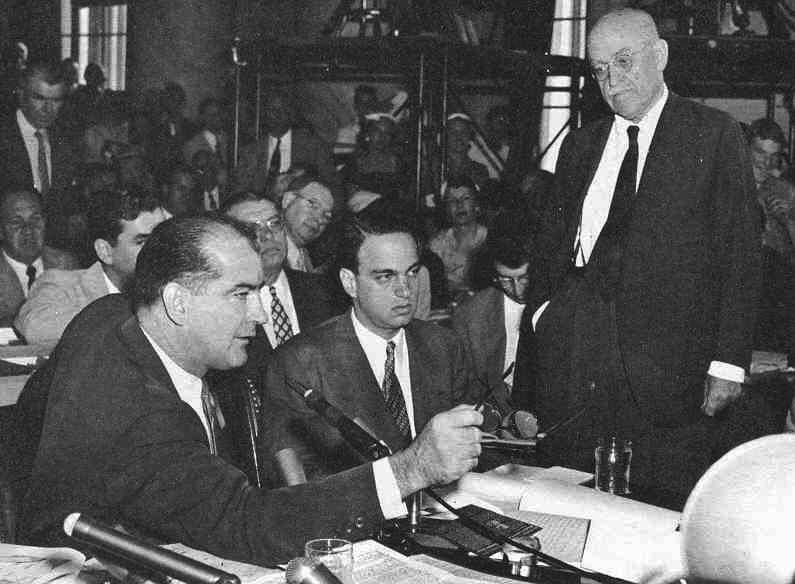 Senator Joseph McCarthy in
action – 1954 (with a disapproving Senator
Ralph Flanders looking on)
Senator Joseph McCarthy in
action – 1954 (with a disapproving Senator
Ralph Flanders looking on)
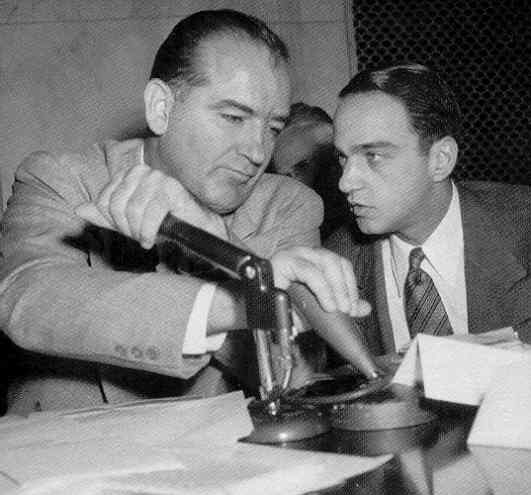
Senator Joe McCarthy conferring
with aide Roy Cohn. Roy Cohn would later go on to be an outstanding "political fixer" in New York
... hired by many wealthy and politically well-placed individuals including Donald Trump in Trump's early business years.
On another front ...
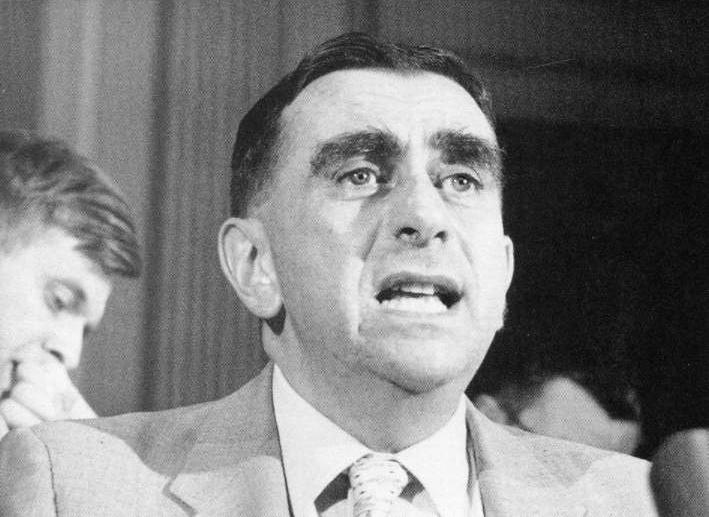 Hungarian-born Edward Teller
- who used Oppenheimer's personal opposition to the development of the hydrogen bomb (1000
times more powerful than the bomb dropped over Hiroshima) as grounds to revoke Oppenheimer's
security clearance for future U.S. sponsored nuclear research – 1954
Hungarian-born Edward Teller
- who used Oppenheimer's personal opposition to the development of the hydrogen bomb (1000
times more powerful than the bomb dropped over Hiroshima) as grounds to revoke Oppenheimer's
security clearance for future U.S. sponsored nuclear research – 1954
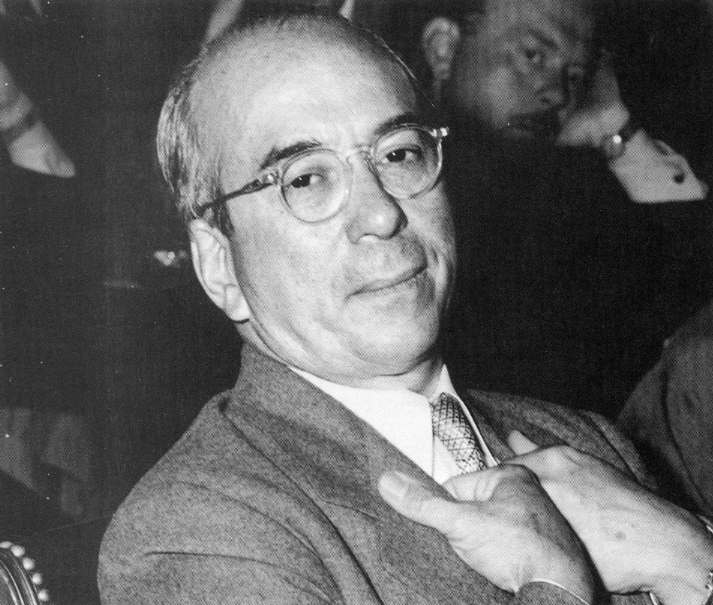 Atomic Energy Commission
chairman Lewis Strauss with a personal grudge against Oppenheimer, portraying him as a possible
Soviet agent who wanted to undercut the U.S. nuclear program – 1954
Atomic Energy Commission
chairman Lewis Strauss with a personal grudge against Oppenheimer, portraying him as a possible
Soviet agent who wanted to undercut the U.S. nuclear program – 1954
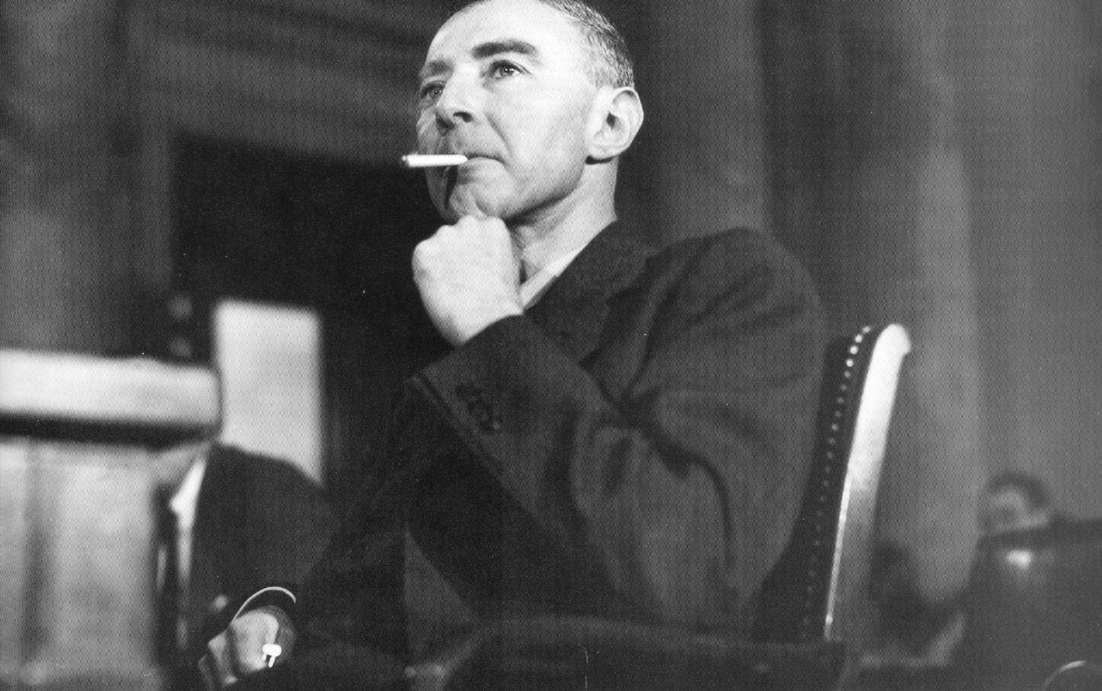
J. Robert Oppenheimer – being
investigated as a security risk
The Harry S. Truman Library
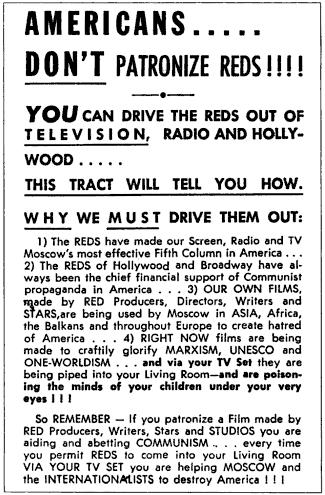 Anti-Communist tract from
the 1950s, decrying the "REDS of Hollywood and Broadway"
Anti-Communist tract from
the 1950s, decrying the "REDS of Hollywood and Broadway"
 Elia Kazan – Broadway and
Hollywood director. His testimony before the
House Un-American Activities Committee in 1952 lost him the friendship of a number of the intellectual
community, including importantly his close friend Arthur Miller
Elia Kazan – Broadway and
Hollywood director. His testimony before the
House Un-American Activities Committee in 1952 lost him the friendship of a number of the intellectual
community, including importantly his close friend Arthur Miller
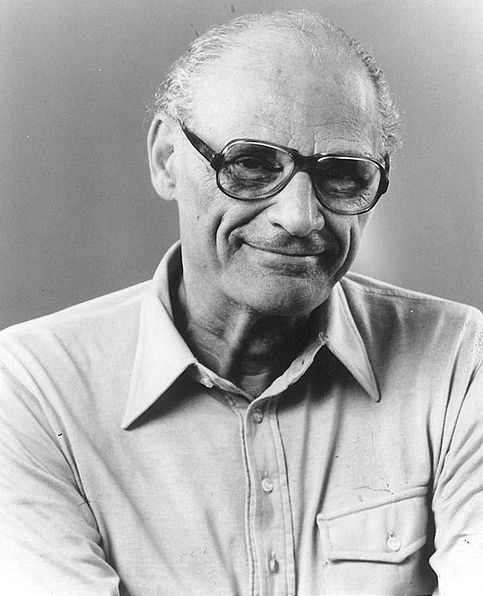 Arthur Miller – playwright
of the 1953 play The Crucible
Arthur Miller – playwright
of the 1953 play The Crucible
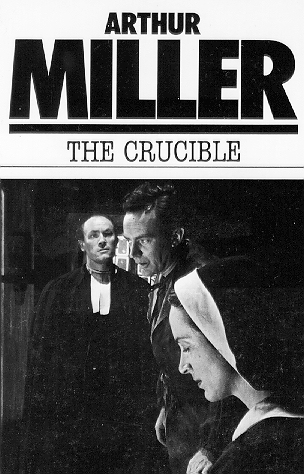
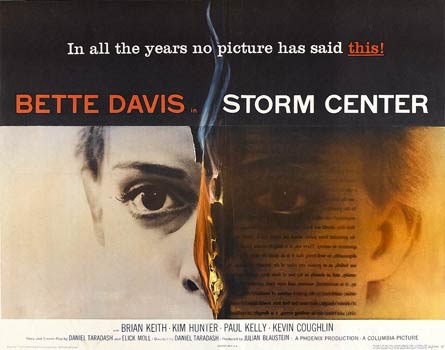 The first Hollywood movie
to overtly take on McCarthyism, Storm Center appeared in 1956. Bette Davis "plays a small-town
librarian who refuses, on principle, to remove a book called The Communist
Dream from the shelves when the local council deems it subversive."
The first Hollywood movie
to overtly take on McCarthyism, Storm Center appeared in 1956. Bette Davis "plays a small-town
librarian who refuses, on principle, to remove a book called The Communist
Dream from the shelves when the local council deems it subversive."
Sneering attitudes of high
brow (intellectual) America concerning low brow (middle class) America
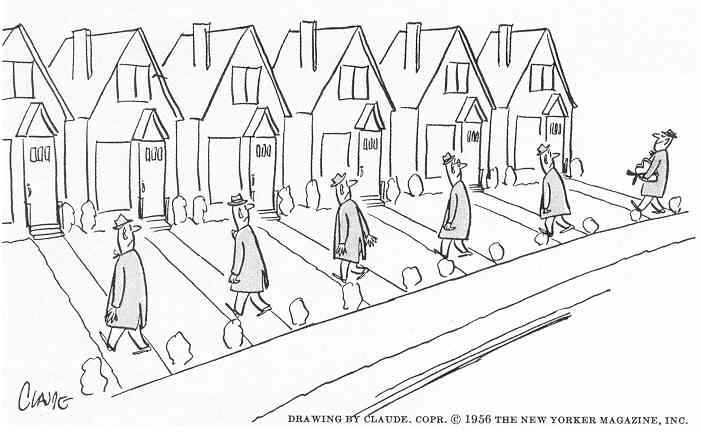 "The Individualist"
"The Individualist"
The New Yorker
Magazine
|
As the 1952 elections approached, the
Republicans had been out of power (at least with respect to the U.S.
Presidency) at this point for twenty years and desperately needed a
comeback in order to return the country to a two-party system. But the
Republicans were deeply split between the very conservative
Midwesterners, who were supporting Ohio Senator Robert A. Taft (elder
son of former President Taft), and the more centrist or moderate
Easterners, who decided to support the widely popular General Dwight D.
Eisenhower.
As the Republican National Convention (RNC) approached, the fight
between the two groups grew extremely bitter. Taft claimed that he
represented the true impulse of Republican politics (little or no
Washington involvement in America’s domestic issues, and a very
cautious, some would even say isolationist, approach to international
issues). However, Eisenhower – more of a centrist in attitudes (and
definitely alarmed at Taft’s isolationist attitudes with respect to
America’s larger challenges abroad) – represented the better chance of
the Republicans of regaining the White House. And thus the Republican
national convention chose Eisenhower over Taft.
There was some concern that Taft might
pull out and run as a third-party candidate spoiler (as did Teddy
Roosevelt against Taft's father in the 1912 elections), splitting the
Republican vote and thus throwing the election to the Democrats. But
Taft and Eisenhower came to some kind of political understanding,
especially as they held similar views on domestic politics (little or
no Washington involvement in America's domestic affairs).
Eisenhower then went on to choose the
young California Congressman Richard Nixon as his running mate, as
Nixon was well-known for his hard stand against Communist infiltration
into American affairs, especially at the upper levels of society (thus
pleasing the Conservative wing of the party), while at the same time
was considered part of the moderate group on all other matters (an
especially strong activist when it came to foreign affairs).
It was at first widely expected that
Truman would run again as the Democratic Party presidential candidate
(the new Twenty-Second Amendment, limiting presidential terms to just
two, actually allowed for Truman to run again). However, as the Korean
War that Truman had committed the nation to was not popular among the
American voters at this point, early primaries did not produce a strong
showing for Truman, and he himself was just really tired. Waging the
Cold War had drained him badly. He thus soon dropped the idea of
running for yet another presidential term.
In fact, in the handful of primaries
prior to the Democratic National Convention (DNC), Senator Estes
Kefauver of Tennessee, who had made a name for himself as a crusader
against organized crime (the Mafia in America) and political corruption
in high places, emerged as a clear front runner. But most delegates to
the DNC were still picked by local (state-wide) political machines,
quite alarmed by Kefauver's anti-corruption campaign. The latter group
thus turned their attention to Illinois Governor Adlai Stevenson, who
actually preferred to run for reelection as Illinois Governor rather
than the U.S. Presidency. But finally he agreed to put his hat into the
ring, and on the third ballot he moved past Kefauver to gain majority
support and thus the Democratic Party candidacy.
The 1952 electoral campaign ultimately
turned around the issue of the disenchantment of the American people
with the Truman Administration, blaming it for causing the Cold War
confusion that had stolen Middle America's hopes for a post-war retreat
from grand global issues – to the comforts of home and a quiet time
enjoying the fruits of victory. The Korean War and the Red Scare had
stolen the dream of a balmy peace from the Americans, and Truman and
the Democrats got blamed for all the frustration. Stevenson, who
attracted the labor vote plus the majority of younger intellectuals,
attempted (unsuccessfully) to distance himself from the Truman legacy
and instead embrace Americans' frustrations towards the Republican
Senator McCarthy, Stevenson attacking Eisenhower for his failure to
come out publicly in opposition to McCarthy.
And then there was the widely popular
Graham crusades, which, though they put no particular name forward as
their preferred presidential candidate, made the particular
moral-political criteria for choosing a president so clear that it
would have been hard to have missed the political direction they were
pointing.
And there was the Republican presidential
candidate Eisenhower himself, whose very character and personal
projection into American politics enhanced enormously the idea of a
Christian America.1
Eisenhower was quick to affirm the critical importance of his own faith
in God – in peacetime as well as in war – and was very supportive of
any effort to put America on those same foundations of faith. And it
was clear to all that this was not mere political posturing. His
obvious sincerity on this matter was a key part of his ability to make
a very strong case for his Christian America. Needless to say, this
made him very attractive not only to the highly pro-Christian business
community – and to the young Graham – it had a huge appeal within
Middle America itself.
Thus in the election that November,
Eisenhower came out with a very strong popular vote (55.2 percent to
Stevensons 44.3 percent), even gaining the majority in three Southern
states (the Democratic Party Solid South was the only area that
Stevenson gained any state wins).2 The electoral vote was even more skewed, with Eisenhower gaining 442 votes to Stevenson's 89 votes.
As things turned out, the country now had not only a Republican president, it also had a Republican majority in the House of
Representatives, and at least a Republican-Democrat tie in the Senate.
1Stevenson
himself came across more as a somewhat lofty intellectual, in contrast
to the war hero Eisenhower, who was very popular with Middle America.
2Southern
Democrats were also known as "Dixiecrats" – but also "yellow dog
Democrats" – for they swore that they would vote for a yellow dog for
elective office before they would ever vote for a Republican (the
Republican Party was still identified in the mind of Dixiecrat
Southerners as the party of the hated Abraham Lincoln)! But that would
begin to change dramatically in the years ahead.
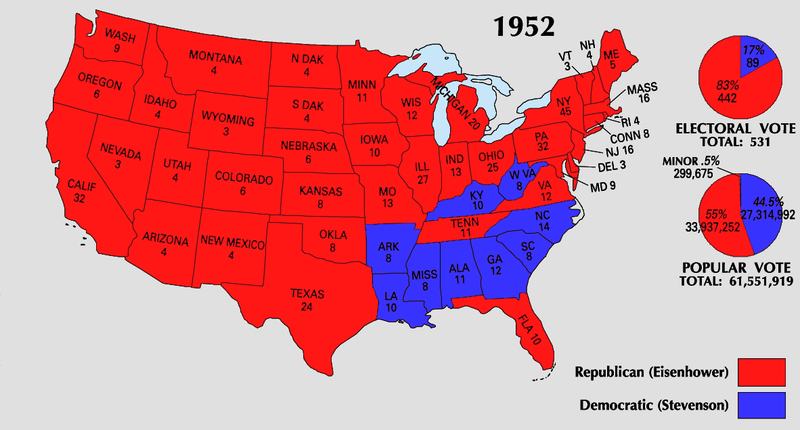
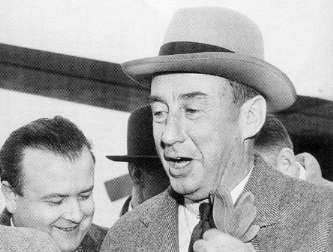 Adlai Stevenson, Governor
of Illinois and Democratic Presidential candidate in 1952
Adlai Stevenson, Governor
of Illinois and Democratic Presidential candidate in 1952
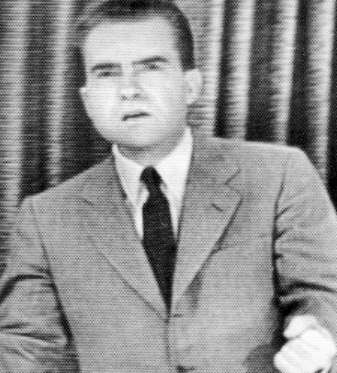 Nixon during and after his
televised "Checkers speech" in which he bared his soul to ward off a cruel (and
false) smear by the Liberal New York Post about his campaign
finances Nixon during and after his
televised "Checkers speech" in which he bared his soul to ward off a cruel (and
false) smear by the Liberal New York Post about his campaign
finances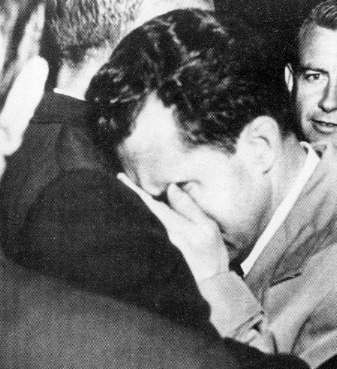
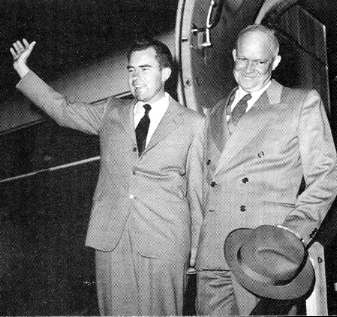 Eisenhower greets Nixon in
West Virginia after his TV speech: "You're my boy!"
Eisenhower greets Nixon in
West Virginia after his TV speech: "You're my boy!"
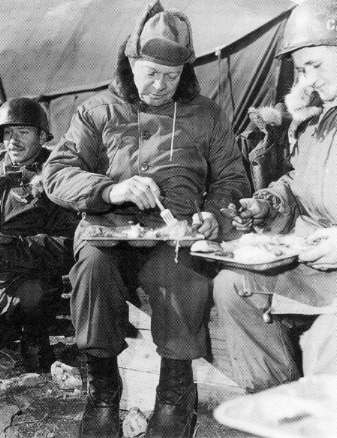 President-elect Eisenhower
visiting his old unit in Korea – December 1952
President-elect Eisenhower
visiting his old unit in Korea – December 1952
National Archives
NA-111-SC-416392
|
Eisenhower: The making of the man
The new president was born third of seven boys in
Abilene Kansas, to a rigorously religious family, especially the
pacifist mother. From her, Eisenhower learned the love of history
(though personally, military history in particular). After graduation
from high school he worked two years to help finance a brother’s
college education, then applied to (with sponsorship by Kansas's U.S.
Senator Bristow) and – to the grand disappointment of his mother – was
accepted to the West Point Military Academy, which offered a free
education. He played on the Academy’s football team, until a knee
injury ended his football playing. But he continued to engage in other
sports and eventually served as a junior varsity football coach at the
Academy. In 1915 he graduated in the middle ranks academically of his
class, a class however that would go on (because of the Great War) to
provide the nation a large number of active officers.
Stationed in Texas after graduation, the
following year (1916) he met and married Mamie Doud, moving to do so
quickly in anticipation of American involvement in the Great War. But
as things turned out he would see no action in the war, and instead was
assigned to various American camps to lead in soldier training. Here he
developed excellent organizational skills, ones that would be called on
later to serve the country. Understandably, he found himself deeply
frustrated when just as he was finally about to be mobilized for action
in France, the Armistice was signed and the fighting in Europe came to
a close.
With the long period of peace that
followed, he took up both further military study and service as a staff
officer in a variety of commands, before being sent to the Philippines
in 1935 to serve under General MacArthur, and the following year
receive the rank of Lieutenant Colonel. He returned to the States at
the end of 1939 where he again served as a staff officer to various
generals, finally attaining the rank of brigadier general in 1941, just
prior to America's involvement in World War Two. Thus far, however,
there was nothing notable about his service that suggested he would one
day find himself commanding the most important and final phase of a war
in Europe.
With America’s entry into that war, he
was first assigned duties with the General Staff in Washington helping
in the planning of American operations in the Pacific. This brought him
to the notice of Army Chief of Staff General George Marshall, who was
greatly impressed by Eisenhower’s strategic mind and his ability to
move things forward in the midst of personality clashes among some of
the Allies’ major military commanders. In mid-1942, Eisenhower was sent
to London to take command of the European Theater of Operations, and
there as Lieutenant General, was given the command of the Allied
Expeditionary Force operating in North Africa (Operation Torch). He
then led Allied operations in Sicily, and after that in Italy itself,
gaining considerable experience in combat command.
By 1944 the Allies were ready to
undertake the attack against Germany, across the English Channel to
France and into Germany itself. Commanding such a massive operation,
and finding success in this last phase of the European war, was
destined to make whoever commanded the operation a major war hero, the
kind whom Americans might look to someday to become the nation’s
president. As we have already noted, Marshall put forward Eisenhower’s
name rather than his own. So it was that Eisenhower received the
appointment, and thus the fame that would follow.
It was also a correct decision because
Eisenhower, amidst a field of military prima donnas (especially
Montgomery, Patton and De Gaulle) was able to keep his attention
focused on winning the war – and keeping these often antagonistic prima
donnas working together – and not just securing a place for himself in
the history books as a battlefield hero. Also, he was quite able to
work easily with General Zhukov, commanding the Soviet Army coming at
Germany from the Russian East.
After the war Eisenhower was named Truman's Army Chief of Staff in
replacement of Marshall, who had been sent to China to try to bring a
reconciliation between the Chinese leaders Chiang Kai-shek and Mao
Tse-Tung (as they were spelled at the time). At first Eisenhower took a
more optimistic view about post-war cooperation with the Soviets than
did his boss, Truman. But by 1947 he too understood the importance of
the policy of containment of Communism.
In 1948 efforts were made by many (both
Democrats and Republicans) to run him as their party's presidential
candidate, but Eisenhower refused. Anyway, given the post-war mood of
the country, it was expected that New York Governor Dewey, running as a
Republican, would win the presidency. In any case, that same year
Eisenhower was hired by Columbia University in New York City to serve
as university president, a strange relationship considering the vast
difference in mentalities that existed between the scholarly and quite
idealistic professors and the quite pragmatic – and deeply religious –
Eisenhower. Tensions would result.
But Eisenhower was much more the scholar
– or at least man of well-thought- through ideals – than the country
understood about him at the time. He was very active on the prestigious
Council on Foreign Relations and a founder of the American Assembly, an
organization designed to bring together leaders from all walks of
American life to go over a broad range of political, economic and social
issues facing the country. Here Eisenhower developed from a starting
point of deep knowledge of military strategy and organization a quite
sophisticated understanding of the broader world of business,
economics, and social-cultural matters. Actually, Eisenhower was vastly
much brighter than his Columbia University professors (many of whom
disliked Eisenhower intensely) portrayed him before the public, and was
learning to cultivate excellent working relations with American
business leaders (whom liberal professors also tended to distrust).
In 1950 he was appointed Supreme
Commander of the North Atlantic Treaty Organization (nonetheless
retaining his position at Columbia until sworn in as U.S. president in
January of 1953). This was an important appointment because Eisenhower
could generate stronger support in Congress for this peacetime
organization and its operations than could Truman, and at the same time
could leverage America's European allies to make a deeper material
commitment (men and money) so as not to make NATO a strictly American
operation.
As a Christian, Eisenhower would prove to
be one of the most active of all individuals to occupy the White House
in support of the Christian faith and its central role in the life of
the nation. He did not come to the White House with much of a Christian
testimony and was not even baptized until once in office. However, as
president he took up regular Sunday attendance at the New York Avenue
Presbyterian Church. And also as president, Eisenhower constantly
reaffirmed the importance of all Americans taking up their particular
Christian responsibilities (including prayer and regular church
attendance) as the nation faced social problems at home and political
and economic problems abroad. To Eisenhower’s understanding of things,
God himself expected no less of America. And Americans seemed glad to
take up this very challenge.
Indeed, it would be during his presidency
that the words "under God" would be added to the Pledge of Allegiance
in 1954, and "In God We Trust" would be confirmed as the nation’s motto
in 1956.3
3The
motto had actually appeared on American coinage since the mid-1800s,
although it would not appear on paper money until the 1950s.
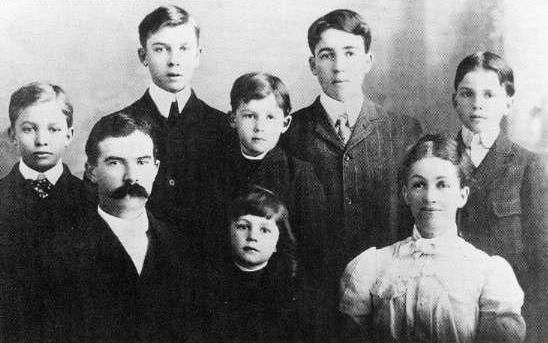 Dwight D. Eisenhower (left)
and his parents and 5 brothers (he was of a family of strict pacifist
Menonites)
Dwight D. Eisenhower (left)
and his parents and 5 brothers (he was of a family of strict pacifist
Menonites)
The Dwight D. Eisenhower
Library
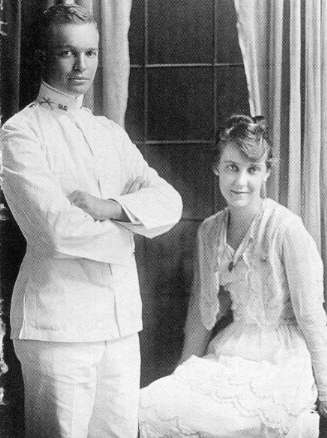 Dwight and Mamie Eisenhower
- 1915
Dwight and Mamie Eisenhower
- 1915
The Dwight D. Eisenhower
Library
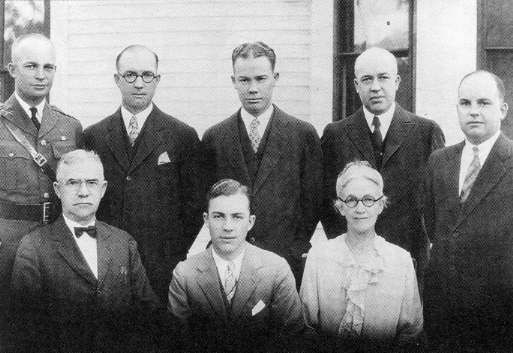 Eisenhower and his family
in 1926
Eisenhower and his family
in 1926
The Dwight D. Eisenhower
Library
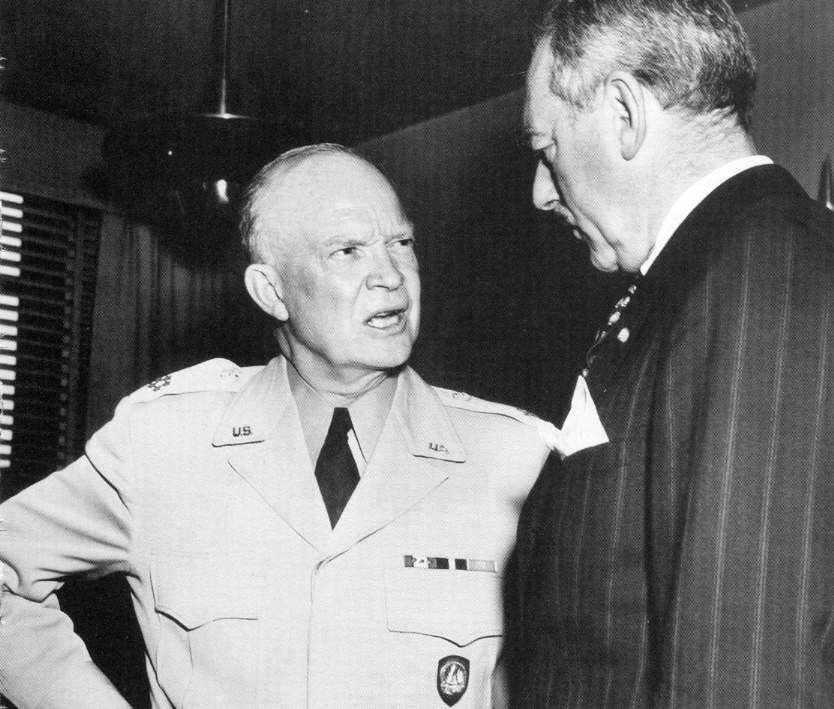 NATO Supreme Commander
Eisenhower
conferring with Truman's Secretary of State Acheson – 1951
NATO Supreme Commander
Eisenhower
conferring with Truman's Secretary of State Acheson – 1951
National Archives
NA-306-PS-52-13171
 Tanks passing in review before
newly installed President Eisenhower, January 1953
Tanks passing in review before
newly installed President Eisenhower, January 1953
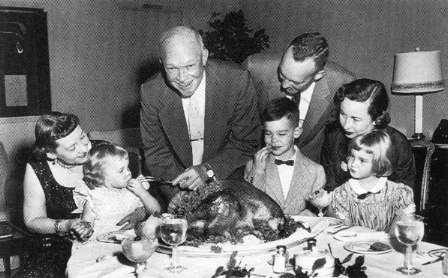 Eisenhower celebrating Thanksgiving
with his family – 1953
Eisenhower celebrating Thanksgiving
with his family – 1953
McCARTHY IS FINALLY BROUGHT DOWN |
|
The matter of Senator McCarthy's stirring of
the fires of the classic Red Scare continued to gnaw away at American
morale. Eisenhower himself did what he could to distance himself from
the McCarthy matter, something that would earn Eisenhower increasing
resentment from the intelligentsia class that McCarthy was fond of
attacking.
Not so fearful of McCarthy was CBS television
reporter Edward R. Murrow, who in his series See It Now presented
episodes in March of 1954 reporting on (carefully chosen) unflattering
statements and actions of McCarthy, concluding the episodes with a
personal comment reflecting on the danger to American freedom posed by
the type of behavior that McCarthy exemplified. McCarthy, sensing a
decline in his popularity, answered back, but only making his case
appear all the worse to the American public. His national popularity
was beginning to slide downward.
But it would eventually be an Army lawyer who
would bring down the demagogic McCarthy by actually challenging the
senator in the course of Senate committee hearings that McCarthy was
conducting in an assault on the U.S. Army itself. The event that turned
matters was the way in June (1954) Army lawyer Welch challenged – with
TV cameras covering the action – McCarthy's doctoring of evidence and
the charlatan behavior of the senator in the way he went around falsely
accusing people of unsubstantiated crimes. McCarthy was not the person
of steel will able to be challenged ... and melted in front of the TV
cameras. This was the signal for fellow senators to come out of hiding
and go after the rogue senator (a two-month hearing over the summer of
1954 scrutinizing McCarthy's senatorial behavior), and finally in early
December vote a motion of censure against McCarthy – rarely done in
Senate history.
And that would be the political end of McCarthy
– who (already something of a heroin addict), although he would
continue to serve (now in isolation) in the Senate, would fall into
alcoholism, and die in mid-1957.
McCarthy's political collapse in 1954 would also ease greatly the
American Red Scare. It would not end America's concern about Communist
aggression, but at least it would direct it more abroad, and lift some
of the cloud of suspicion that had been too long tearing at the
American nation itself.
|
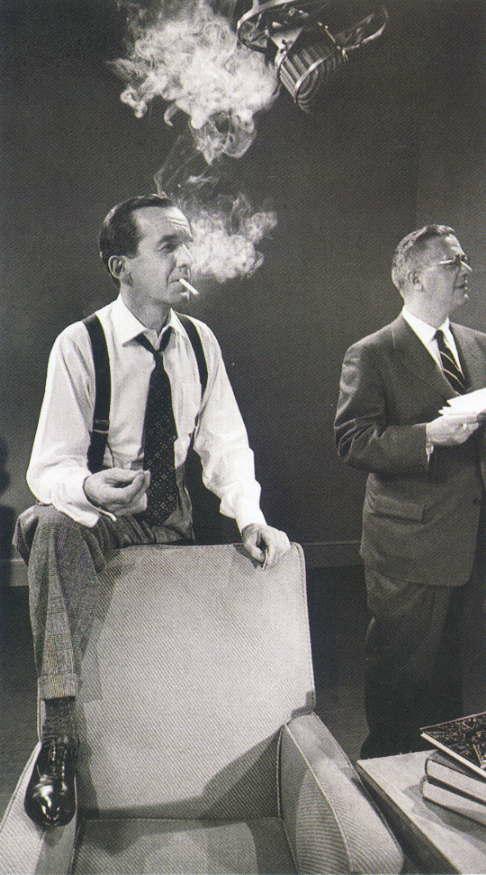 Edward R. Murrow takes on
Joe McCarthy
Edward R. Murrow takes on
Joe McCarthy
| Radio newsman of World War
Two fame, Edward R. Murrow, turned to TV in 1951 with his own program, See
It Now. In the spring of 1954 he devoted two of his programs to exposing
the dangers of McCarthy and McCarthyism. |
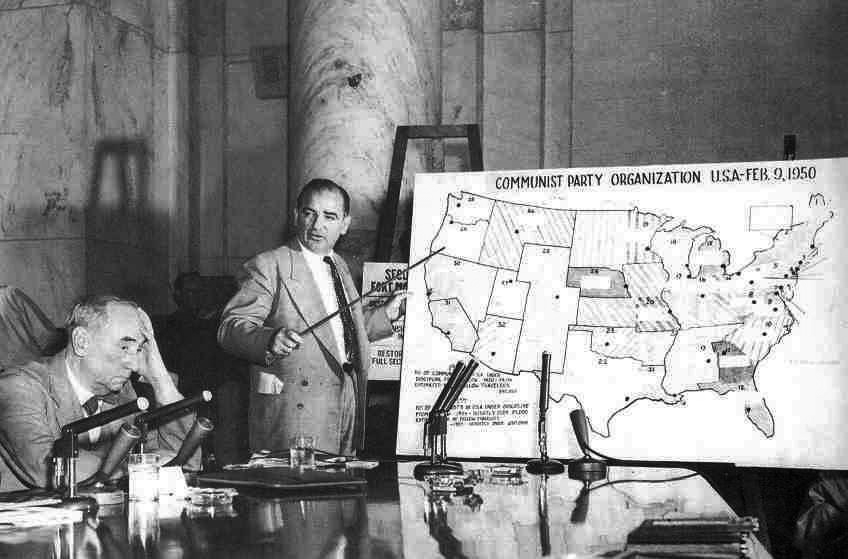 Wisconsin Senator Joe McCarthy
on the attack against the U.S. Army command
Wisconsin Senator Joe McCarthy
on the attack against the U.S. Army command
McCarthy is supposedly demonstrating
the full extent of the Communist infiltration into American life (with statistics completely fabricated
by himself personally) even into the law firm of Joseph
Welch (seated left).
Welch has been defending the US
Army against McCarthy's accusations of its being full of Communists.
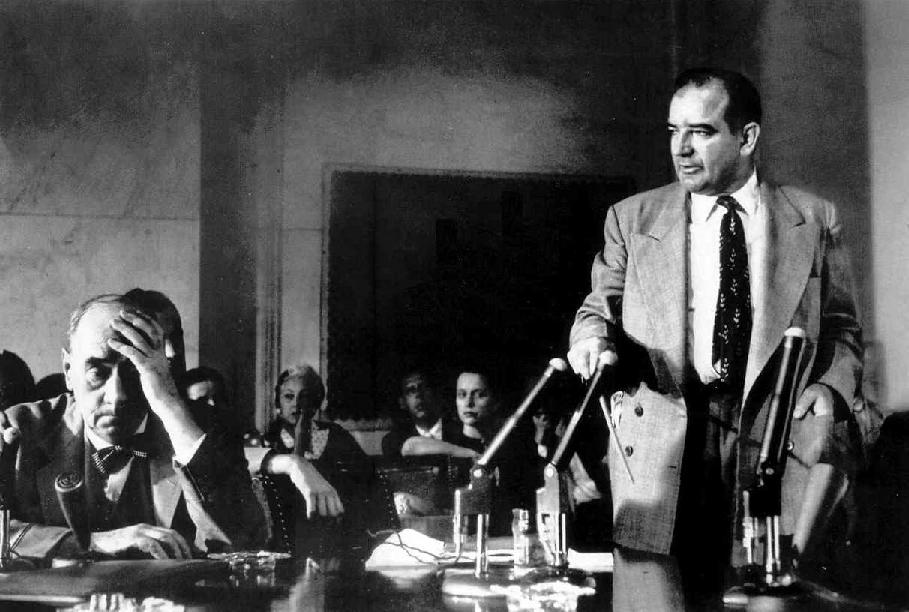 Senator McCarthy haranguing
Army Counsel Joseph Welch for his law partner Fred Fisher's membership in the National Lawyers Guild which McCarthy ridiculously termed "the legal bulwark of the Communist
Party" – June 1954
Senator McCarthy haranguing
Army Counsel Joseph Welch for his law partner Fred Fisher's membership in the National Lawyers Guild which McCarthy ridiculously termed "the legal bulwark of the Communist
Party" – June 1954
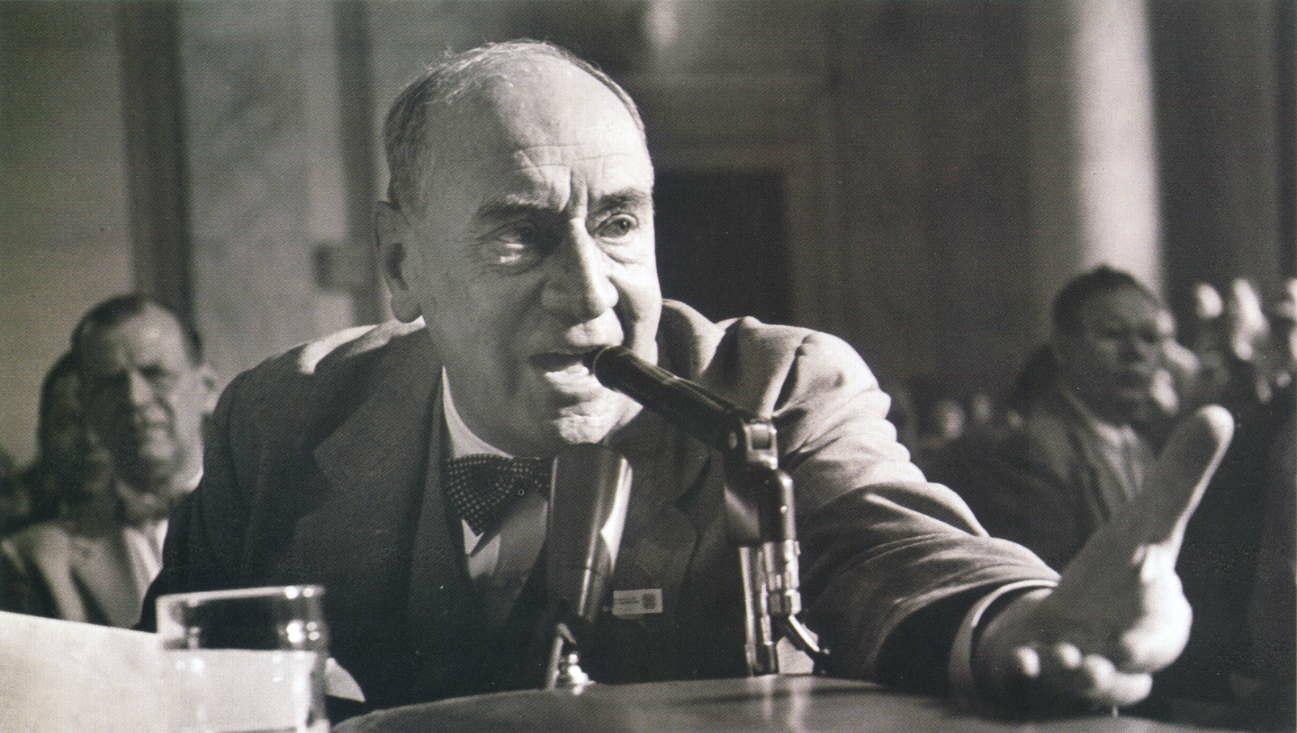
Army attorney Joseph Welch
to Senator Joseph McCarthy: "Have you no sense of decency, sir?" ... his response to a McCarthy
smear of a young law partner as being a Communist suspect.
MIDDLE AMERICA SETTLES IN
... QUITE SPECTACULARLY! |
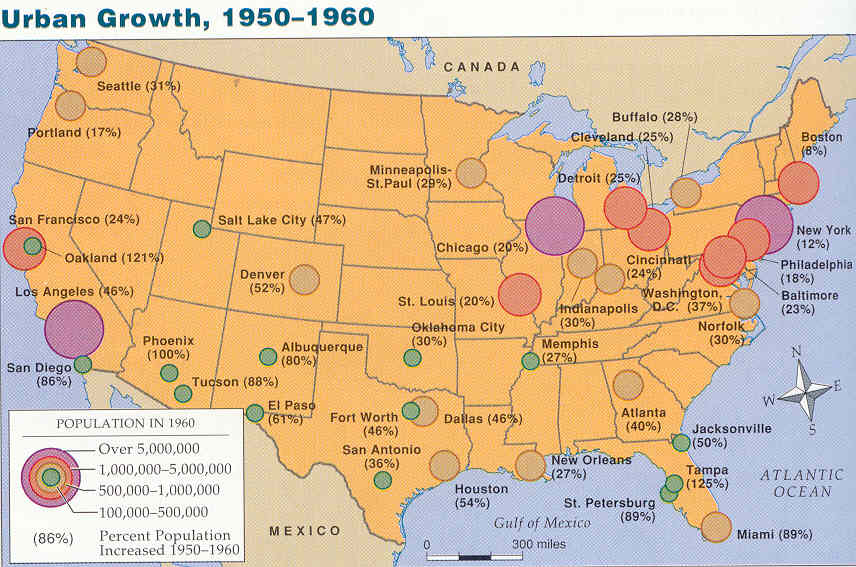
A major contributor to the
new American scene was, of course, the automobile
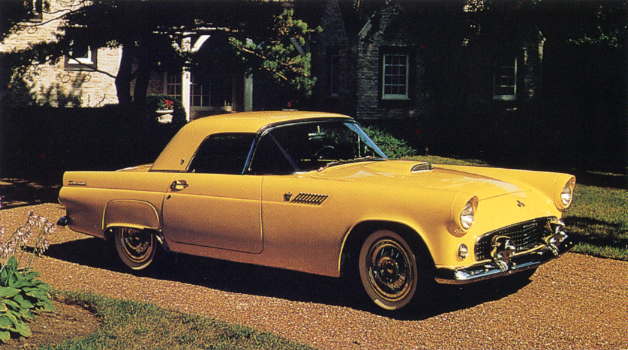 The 1955 Ford Falcon – a
major hit with America's younger drivers
The 1955 Ford Falcon – a
major hit with America's younger drivers
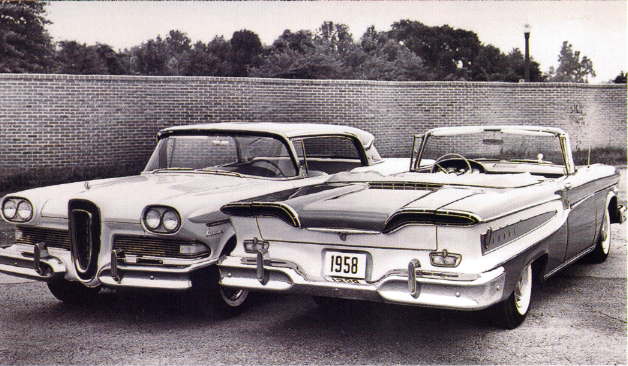 An expensive failure in innovative
automobile design: the Ford Edsel – 1957
An expensive failure in innovative
automobile design: the Ford Edsel – 1957
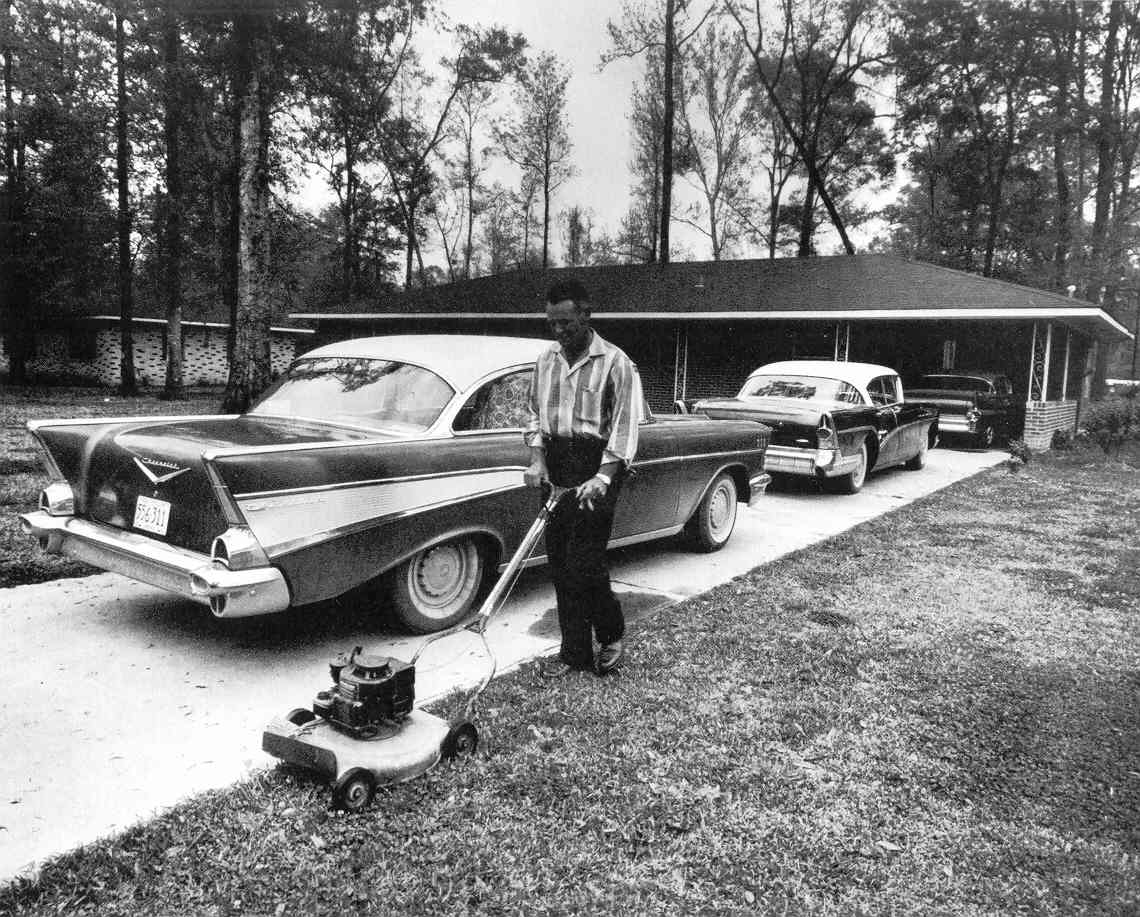
Lawn care in the
suburbs
Along with the automobile
was the drive-in fast-food restaurant
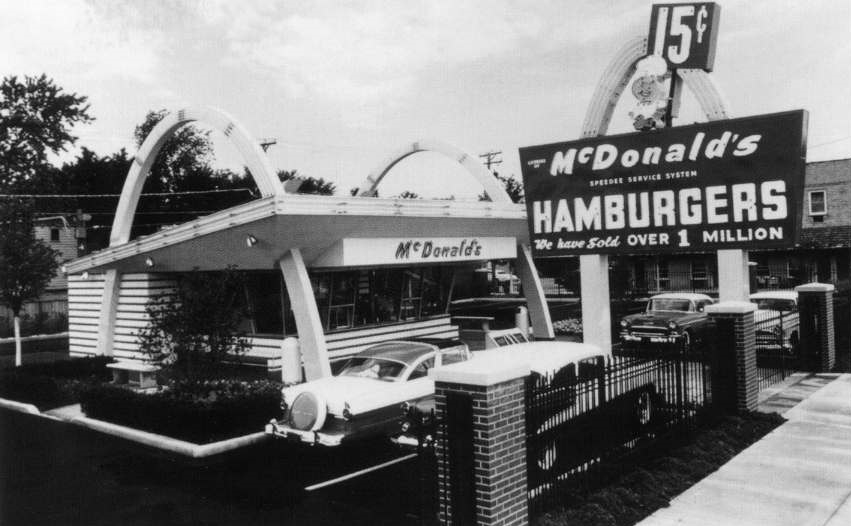
A McDonald's fast-food restaurant – San Bernardino, California – mid-1950s
One of the signs of the new
lifestyle was the TV dinner
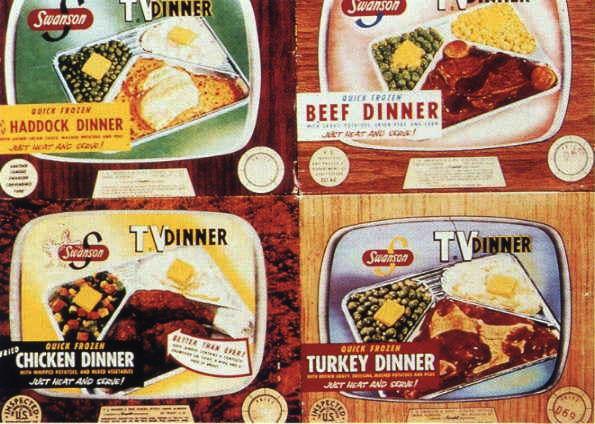 TV dinners – a new "must"
so that TV could be watched without disruption. By 1954 when the frozen 25-minutes-to-cook
dinner was introduced, 26 million American households had TVs
(up from 172 thousand in 1948)
A big part of the new
picture
is the television
TV dinners – a new "must"
so that TV could be watched without disruption. By 1954 when the frozen 25-minutes-to-cook
dinner was introduced, 26 million American households had TVs
(up from 172 thousand in 1948)
A big part of the new
picture
is the television
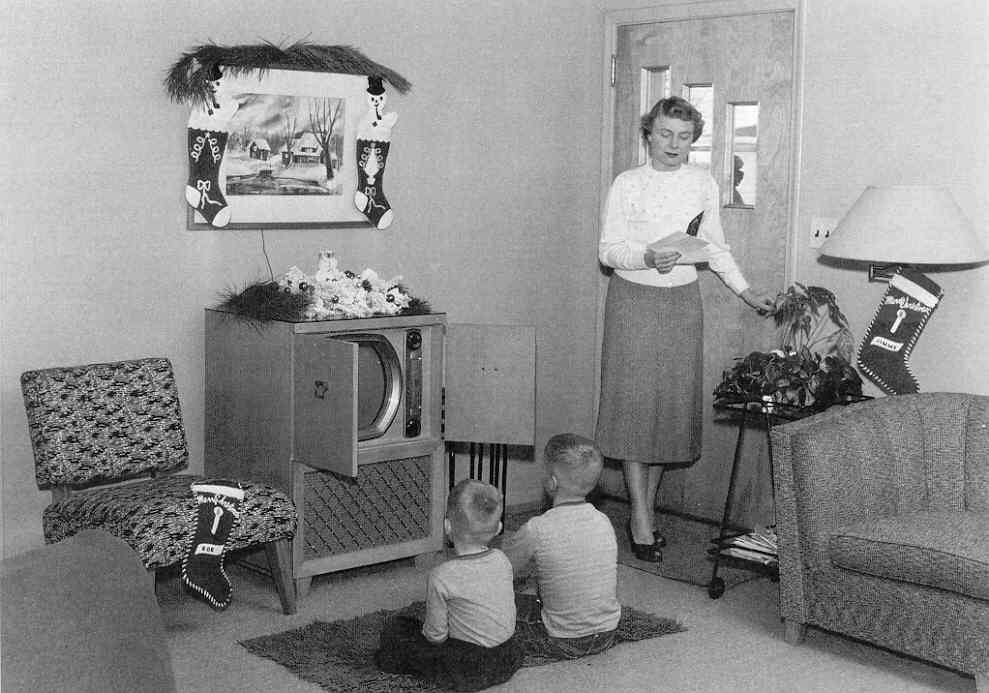 The living room in a 1950s
American home
The living room in a 1950s
American home
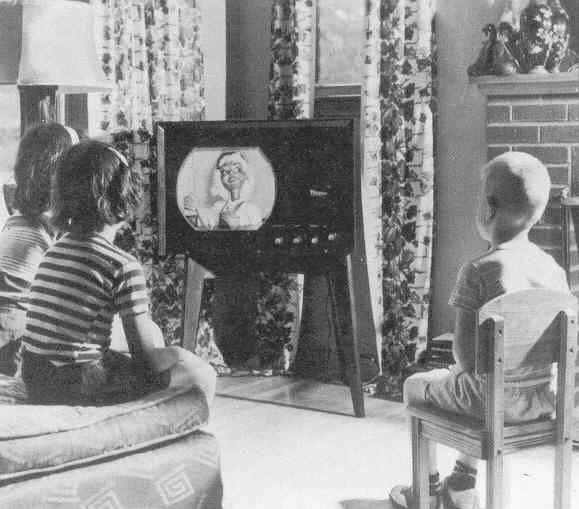 Typical living room scene
- 1950s
and for the man of the family
. . .
Typical living room scene
- 1950s
and for the man of the family
. . .

The first televised NFL game
(Colts vs. Giants championship game) – December 28, 1958
One of the better features
of the new TV culture was the TV evening news – which brought the larger
world right into the American livingroom
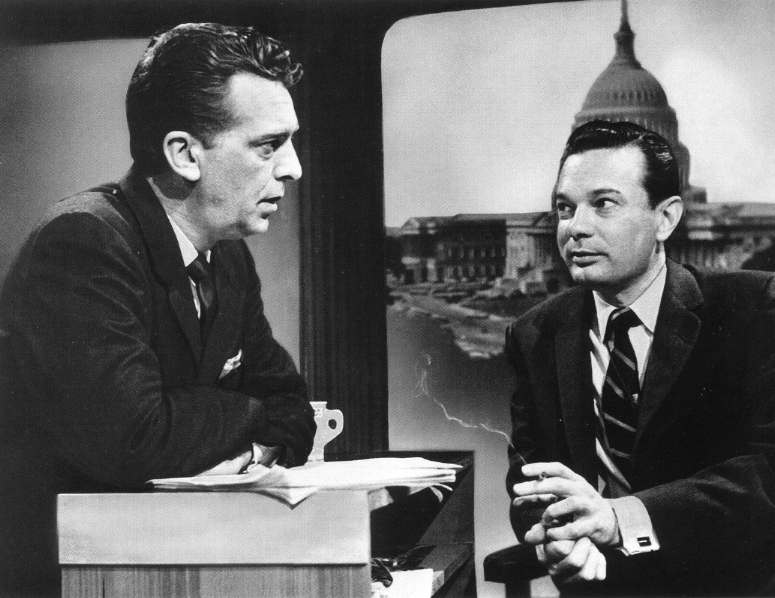 NBC's double-anchor news-team,
Chet Huntley and David Brinkley – 1956-1970
NBC's double-anchor news-team,
Chet Huntley and David Brinkley – 1956-1970
And there was also the totally ridiculous ... to make America laugh
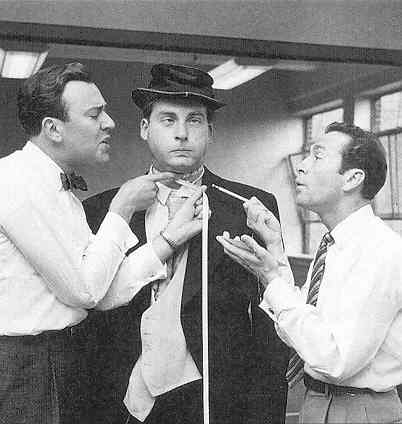 Sid Caesar: The Show of
Shows
Sid Caesar: The Show of
Shows
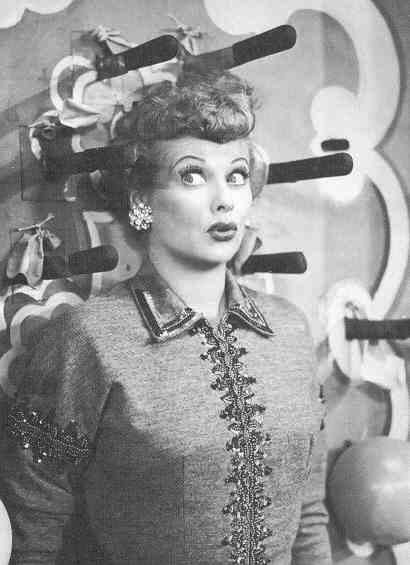 Lucille Ball and Milton Berle – 1950s
Lucille Ball and Milton Berle – 1950s
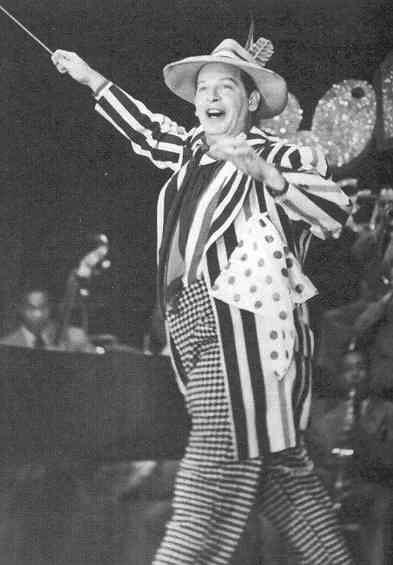
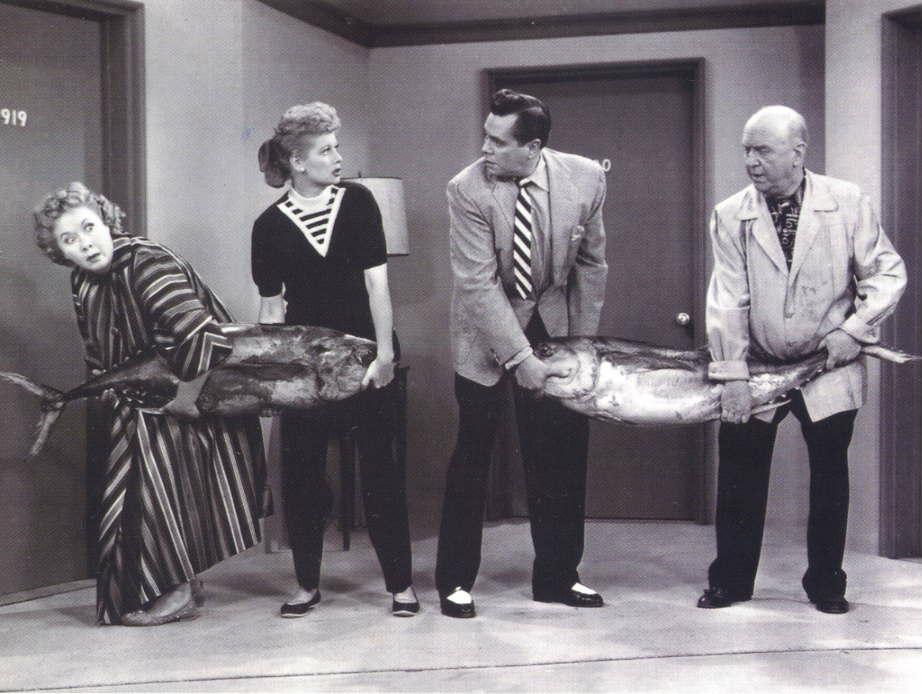
An "I Love Lucy"
episode
Beyond the material enrichment of the
average American went also some hunger for cultural enrichment:
The American Clubwoman – whose full-time
job was to bring refinement to the American household
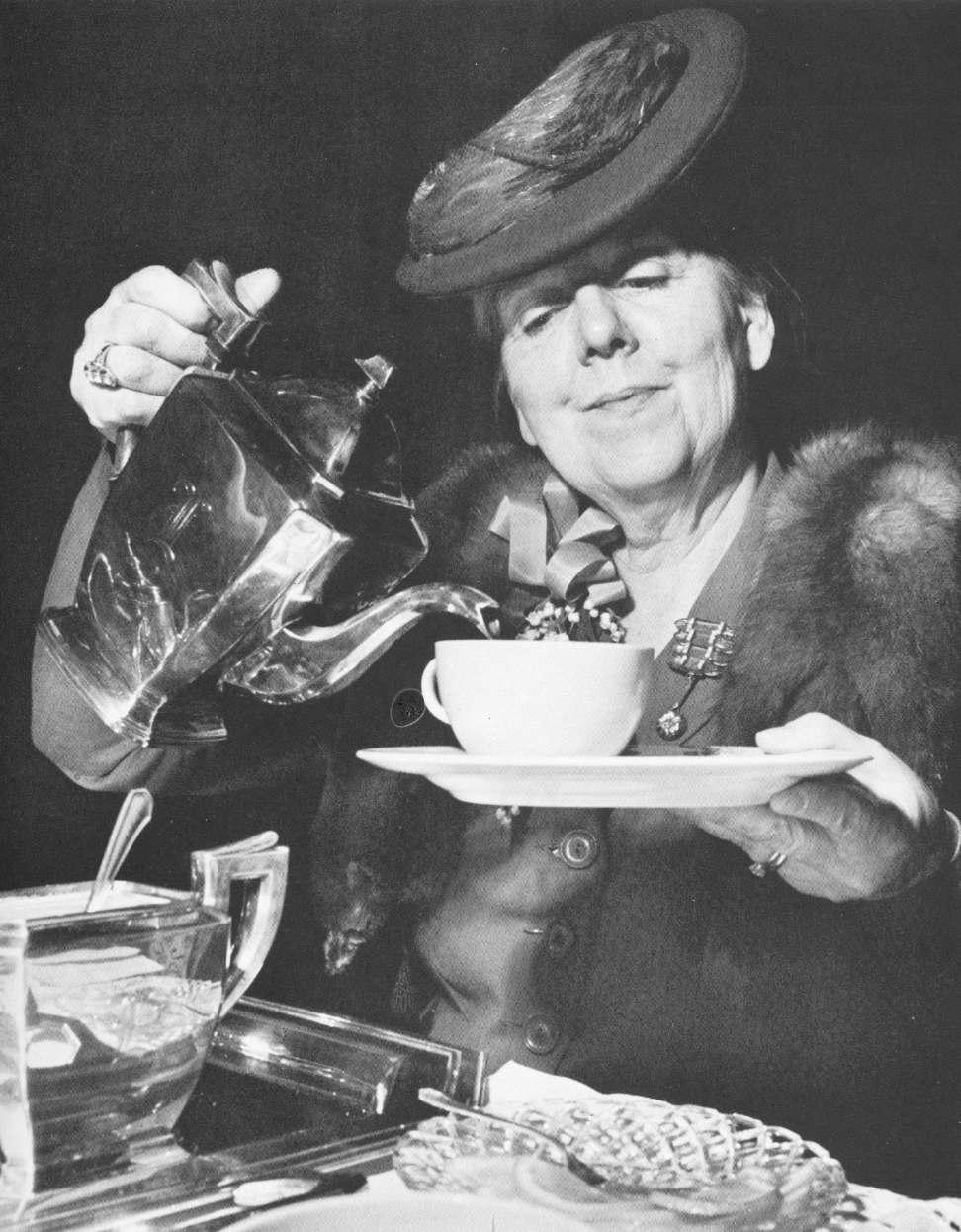 A Woman's Club tea in Chevy
Chase, Maryland
A Woman's Club tea in Chevy
Chase, Maryland
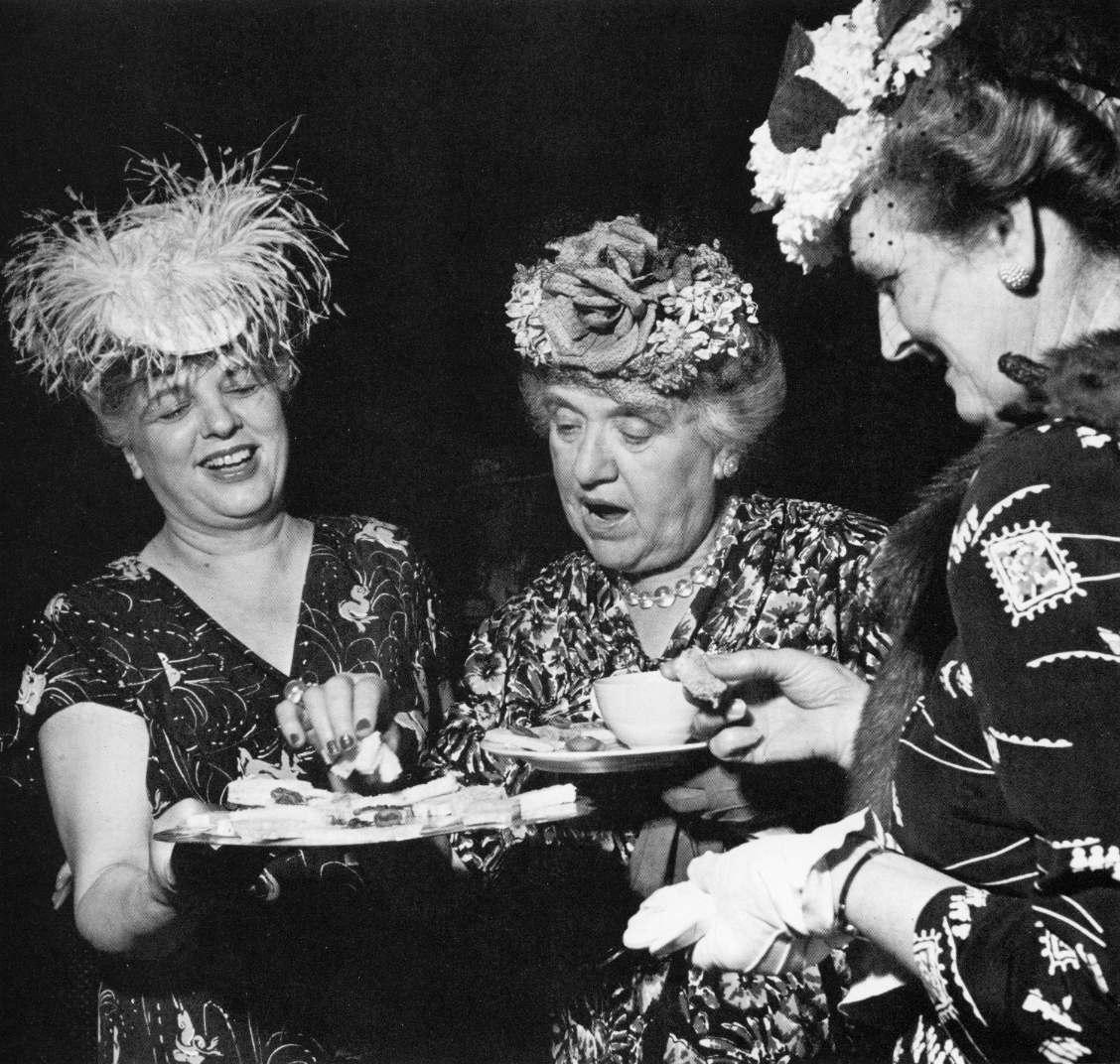
A Woman's Club tea in Chevy
Chase, Maryland
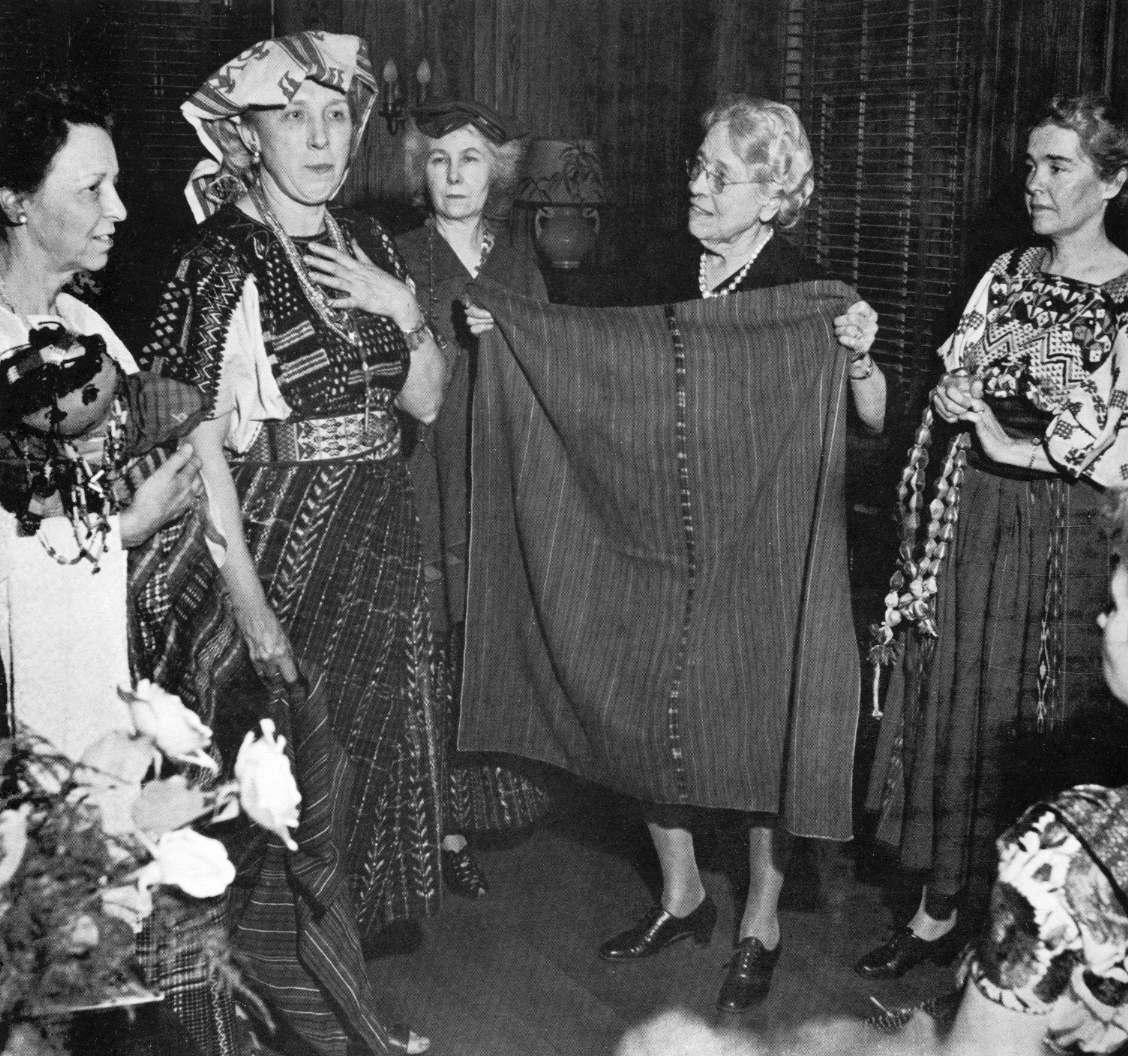
Cultural Enrichment:
Experimenting with Latin American tastes
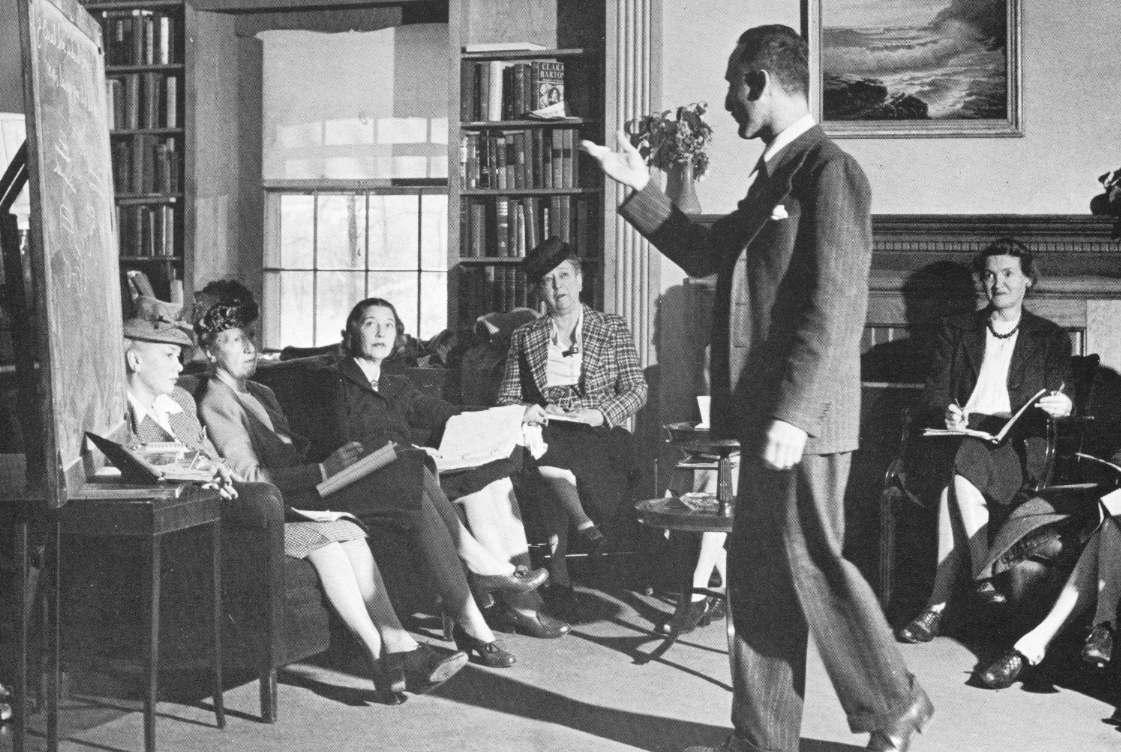
Listening to Sr. Cromayer
explain Latin culture to the weekly Woman's Club Spanish class
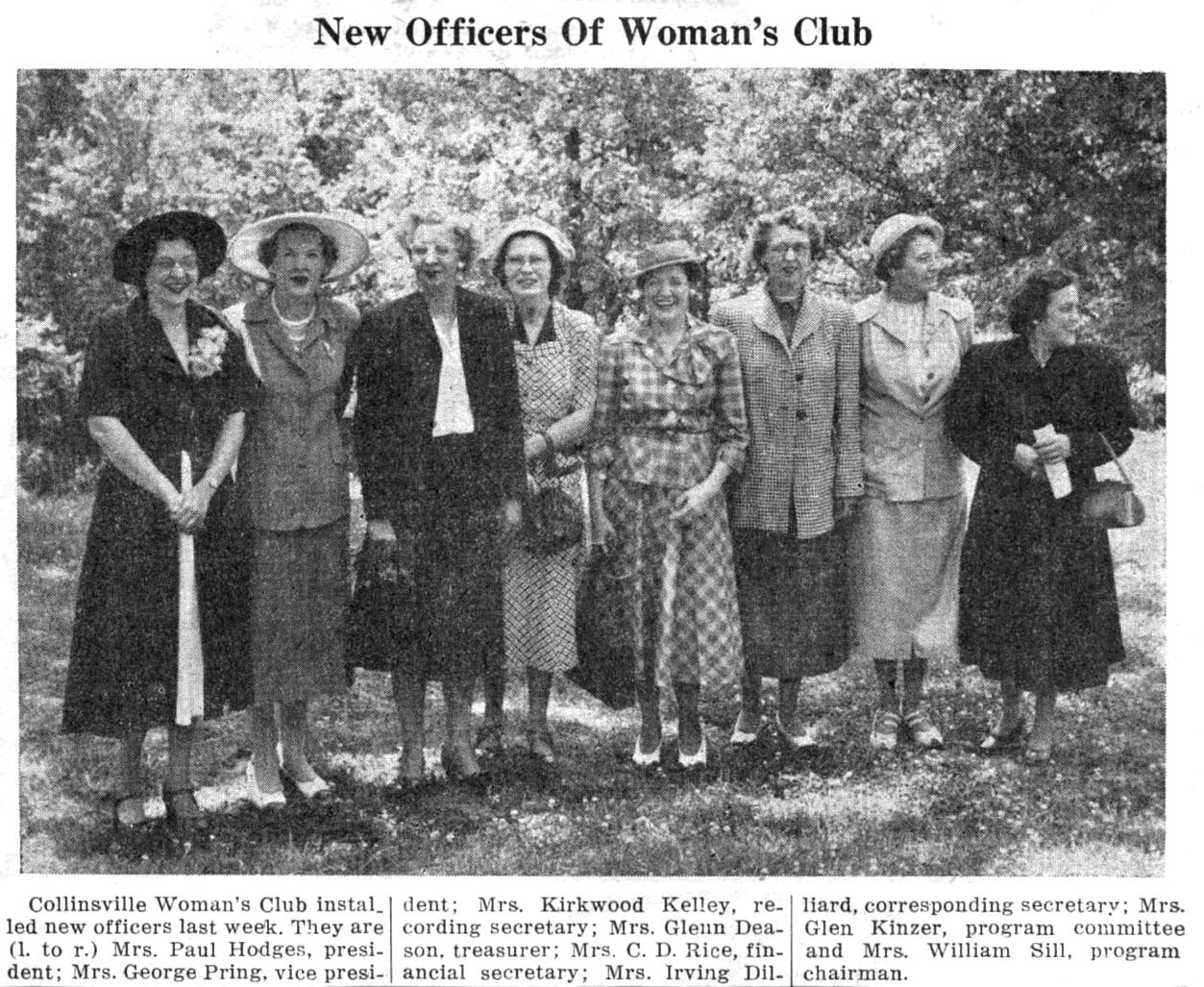
June 15, 1951 announcement
in the Collinsville Herald about the election of officers
of the Collinsville Women's Club
Miles Hodges
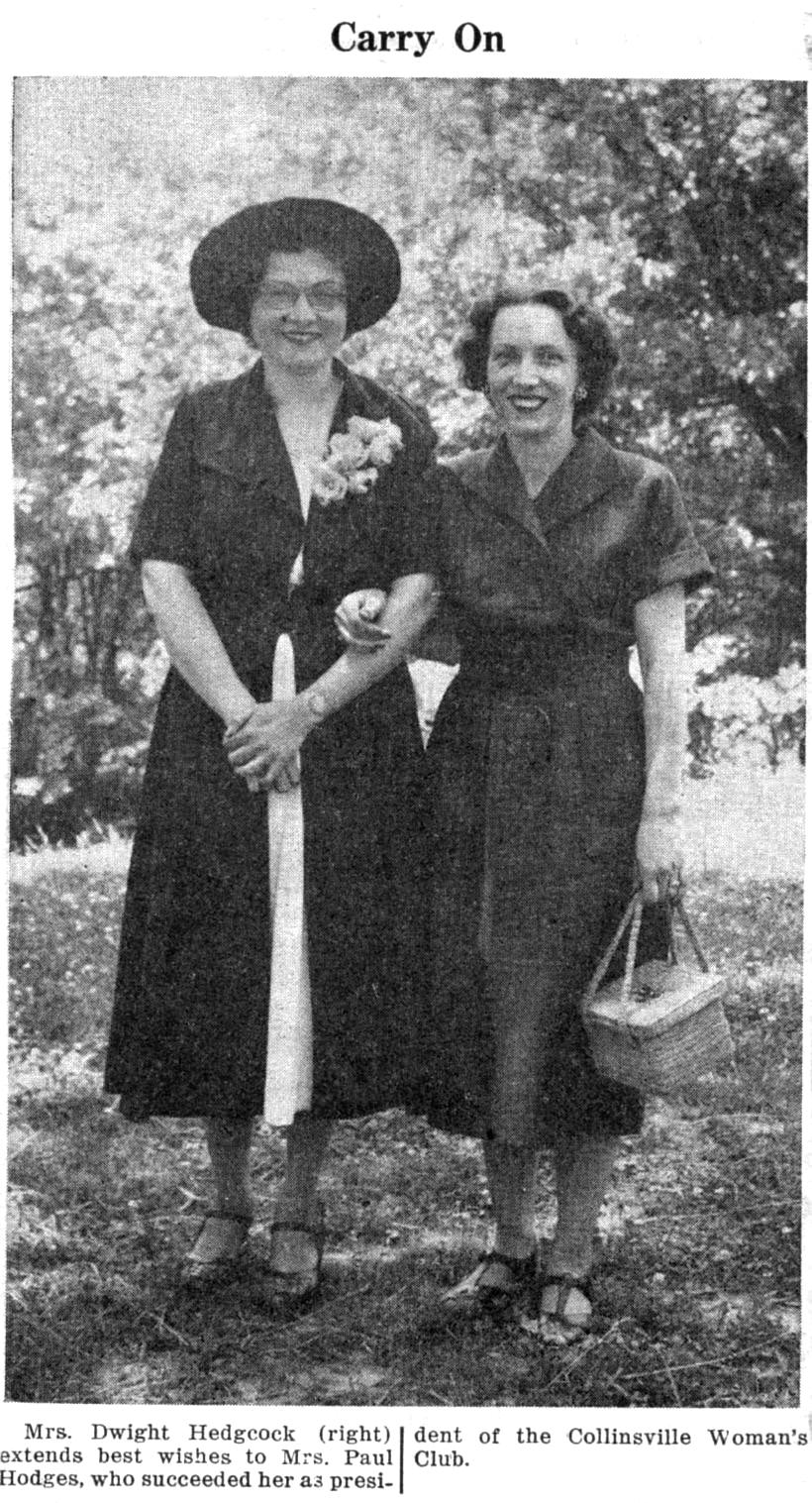
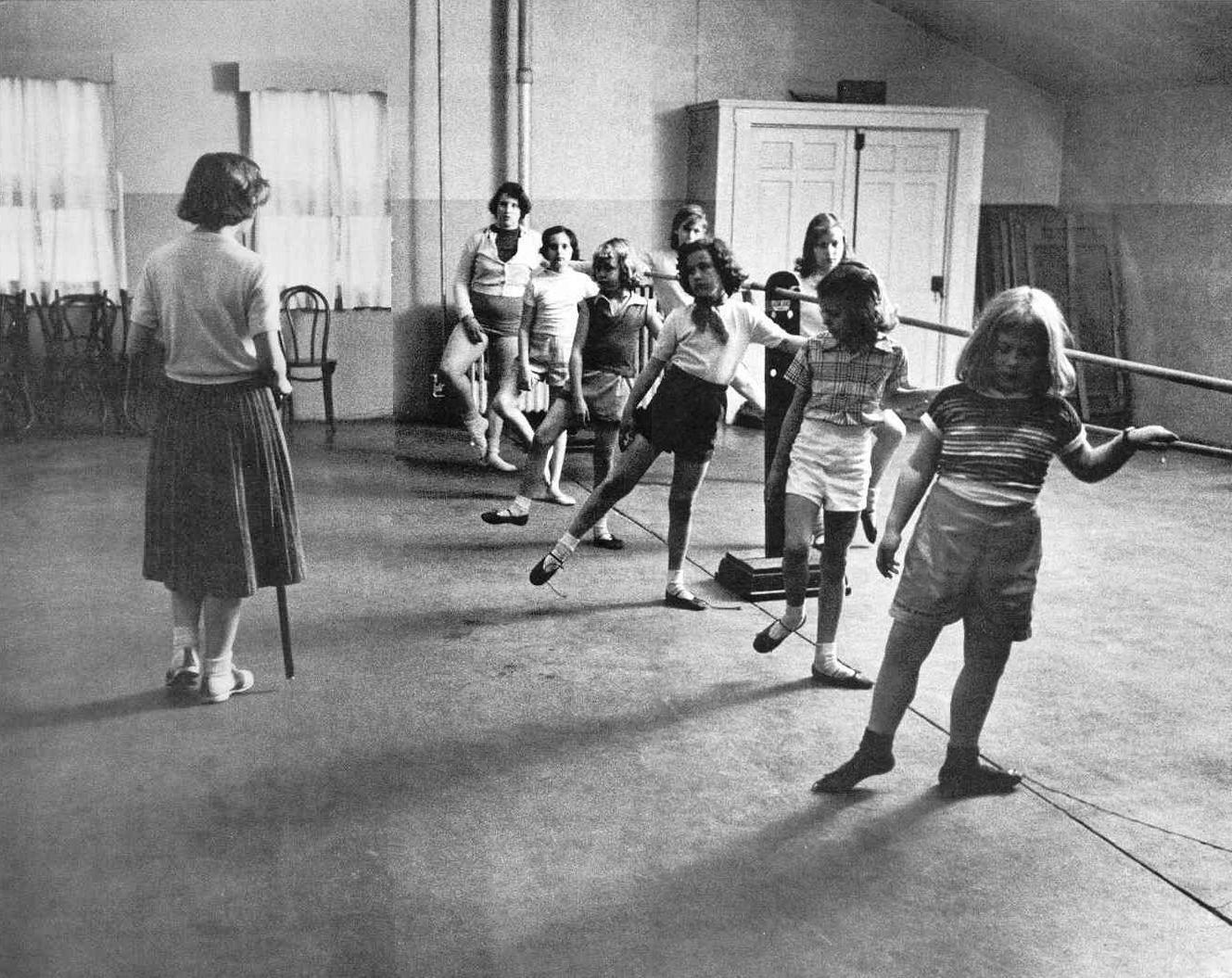
My mommy wants me to be cultured
too
The American male, meanwhile,
continues to serve loyally in peace, as he served in war, submitting himself to the
needs of others: as the breadwinner of the family, employed by one or another of the
great American corporations – to whom he will dedicate his life in labor as he did his country
in military service. He is a true “Veteran” or
”Vet”
|
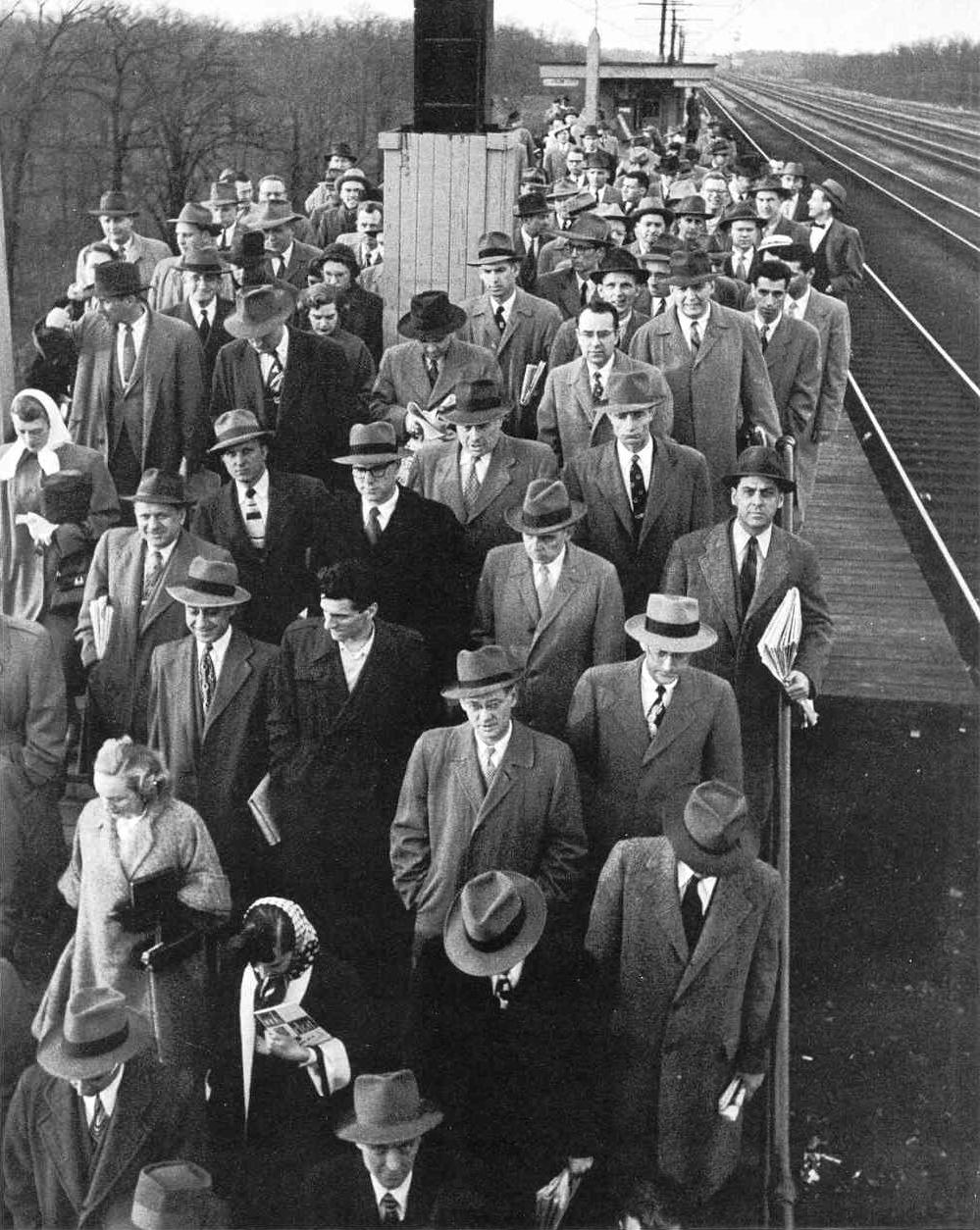 Commuters on their way to
work
Commuters on their way to
work
BUT A "BOOMER" YOUTH CULTURE QUITE DISTINCT FROM MIDDLE AMERICA IS DEVELOPING |
|
Directives to the Boomer:
"Challenge all authority"
But the experience would leave one matter
behind as a cultural legacy, a matter that would explode into a major
cultural upheaval in the following decade (the 1960s).
Because of the depth of the Red Scare in
America, a fateful decision in the early 1950s was made by Vet parents,
concerned about the possible susceptibilities of their Boomer children
to the subtle appeals of totalitarian Communism. Vet parents were
terrified by the stories of how easily Hitler had brainwashed German
youth with his Nazi propaganda, and likewise stories of how Stalin had
easily brainwashed Russian youth into turning their parents over to
Soviet authorities whenever the parents were caught engaging in
anti-state crimes (not just merely criticizing Stalin but even just
merely continuing to honor their Christian heritage). The book 1984
also had made it very clear how the new world of technology had made it
easy for those in authority to break into the private world of the
common citizenry and take over even their personal thought processes.
Thus something needed to be done to ensure that no such capture of the
minds of Americas youth by (Communist) ideologues should ever come to
America. The Red Scare made this matter a huge educational priority in
America.
Thus, as an antidote to the appeals of
(Communist) authoritarianism, the Vet parents were determined to train
their Boomer youth in the art of careful challenge of all voices posing
as authority. "Think for yourself and thereby remain free" was the
general theme. This theme was stressed not only at home but also
importantly at school, complete with essay contests in which students
wrote on the subject "I speak for freedom" and "what America means to
me," in which freedom, freedom, freedom – that is personal freedom,
freedom, freedom – was stressed as the goal of all life, above all
other considerations.
Little did the parents know that they
themselves were brainwashing their own children in a way that would
work to counter the very strong social instincts (serving each other
and the nation under any and all circumstances) characteristic of the
Vet generation. The Vets were creating in the Boomer youth a generation
that would find it very hard to give over the self to anything larger
than that self in jobs, in marriages, in social (and church)
affiliations – and certainly also in the idea of patriotism. Boomers
would grow up to see such affiliations not only compromising their
personal freedom but even being aspects of backward, even evil
loyalties. The day would come when even American flags would burn in
Boomer protest against "dangerous patriotism."
Tragically, the Vets were very careful during
the Boomers' growing up years of the 1950s not to impose on their
children any difficult or self-sacrificing social values of their own
(that would itself have constituted a form of the very authoritarianism
that they were teaching the youth instinctively to challenge) –
supposing that their own well-disciplined middle-class values would
develop naturally, of their own, within the free-thinking minds of
their Boomer children. Little did the Vets understand how their own
very strong values did not originate naturally from birth onwards, but
were the results of very hard lessons learned from the life that they
themselves were put through in growing up and taking their place as
responsible adults.
Tragically none of those lessons, nor the social discipline they generated, would register with the Boomer youth.
A distinctly hedonistic youth culture
This new anti-authoritarian approach to
educating a new generation of Americans was combined with the great
prosperity that greeted America after the war. It must be remembered
that as youth during the Great Depression of the 1930s, the Vet
generation had to work hard alongside their parents, and then in the
1940s serve the nation heroically in World War Two. The Vets thus were
never really privileged to develop a youth culture and had little
understanding of what that was all about. Now with the great wealth
they possessed during the 1950s, the Vets were intent that their Boomer
children should never suffer the loss of the experience of youth such
as the Vets had been deprived of in their own growing up years. The
Vets consequently showered the Boomers with plenty.
But this tended to have the unexpected effect
of creating a very distinct and very strong youth culture, one with its
own music, its own social code, its own lifestyle. This in itself was
enough to cause eventually inter-generational tensions ("their hair is
too long, they dance to this horrible jungle music, they drive too
fast, " etc.). But with an independently wealthy youth culture combined
with the Cold War effort to create a generation that took nothing on
authority – that was taught to evaluate everything from the perspective
of what seemed true or good to the individual alone – a socially lethal
generation was gradually being created. By the beginning of the 1960s,
as the first of the Boomers entered their teens, this explosive force
was ready to be set loose in America.
|
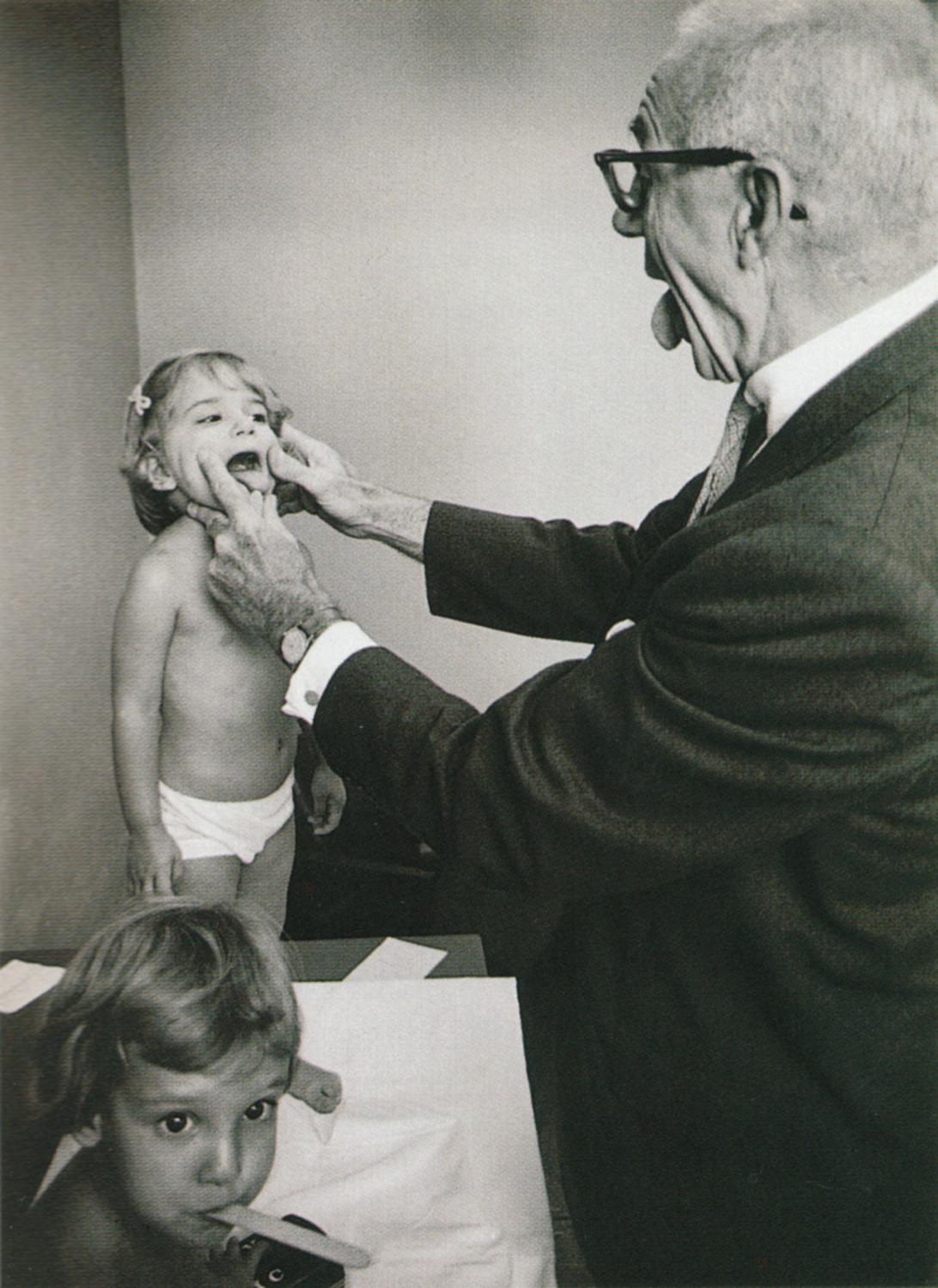
Dr. Benjamin Spock
(1903-1998). A whole generation of Boomers
were raised on his somewhat permissive philosophy
For the little guys, there were such
shows as Hopalong Cassidy
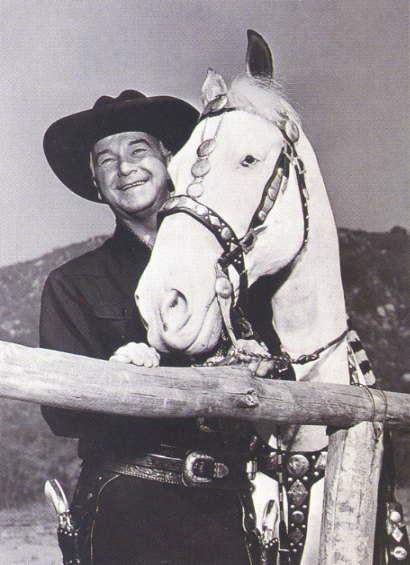 Hopalong Cassidy, a favorite
kids' TV program (early 1950s). William Boyd bought up the TV rights to
66 of his B-grade movies – and turned them into major TV hits with
the kids
Hopalong Cassidy, a favorite
kids' TV program (early 1950s). William Boyd bought up the TV rights to
66 of his B-grade movies – and turned them into major TV hits with
the kids
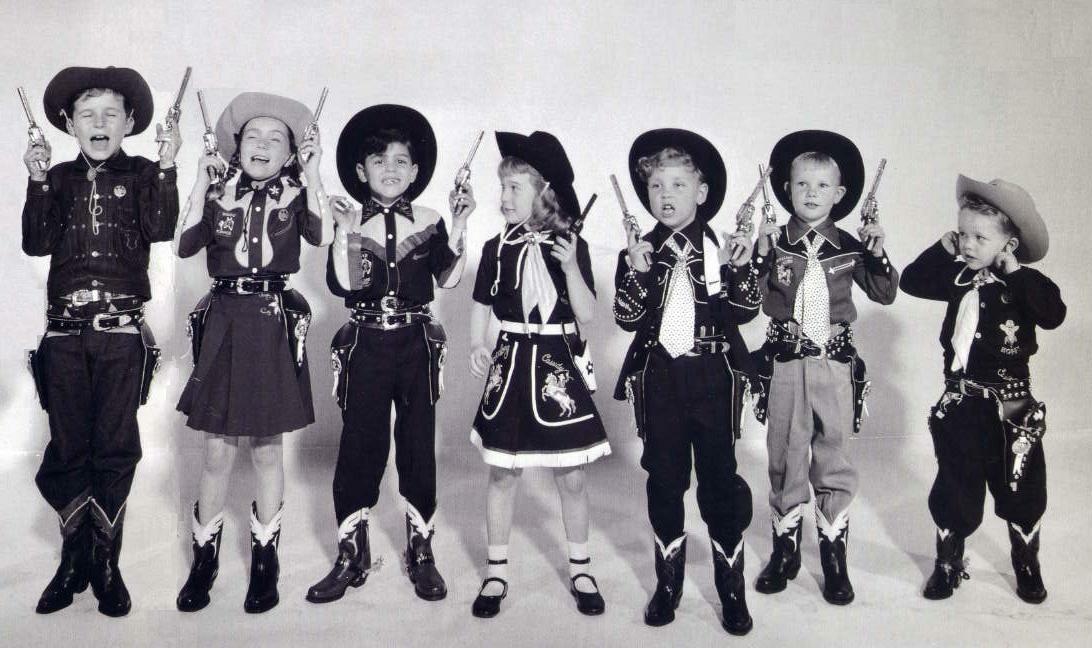
Hopalong Cassidy gear. Boyd also licensed and marketed cowboy
gear -- which sold very well with the kids.
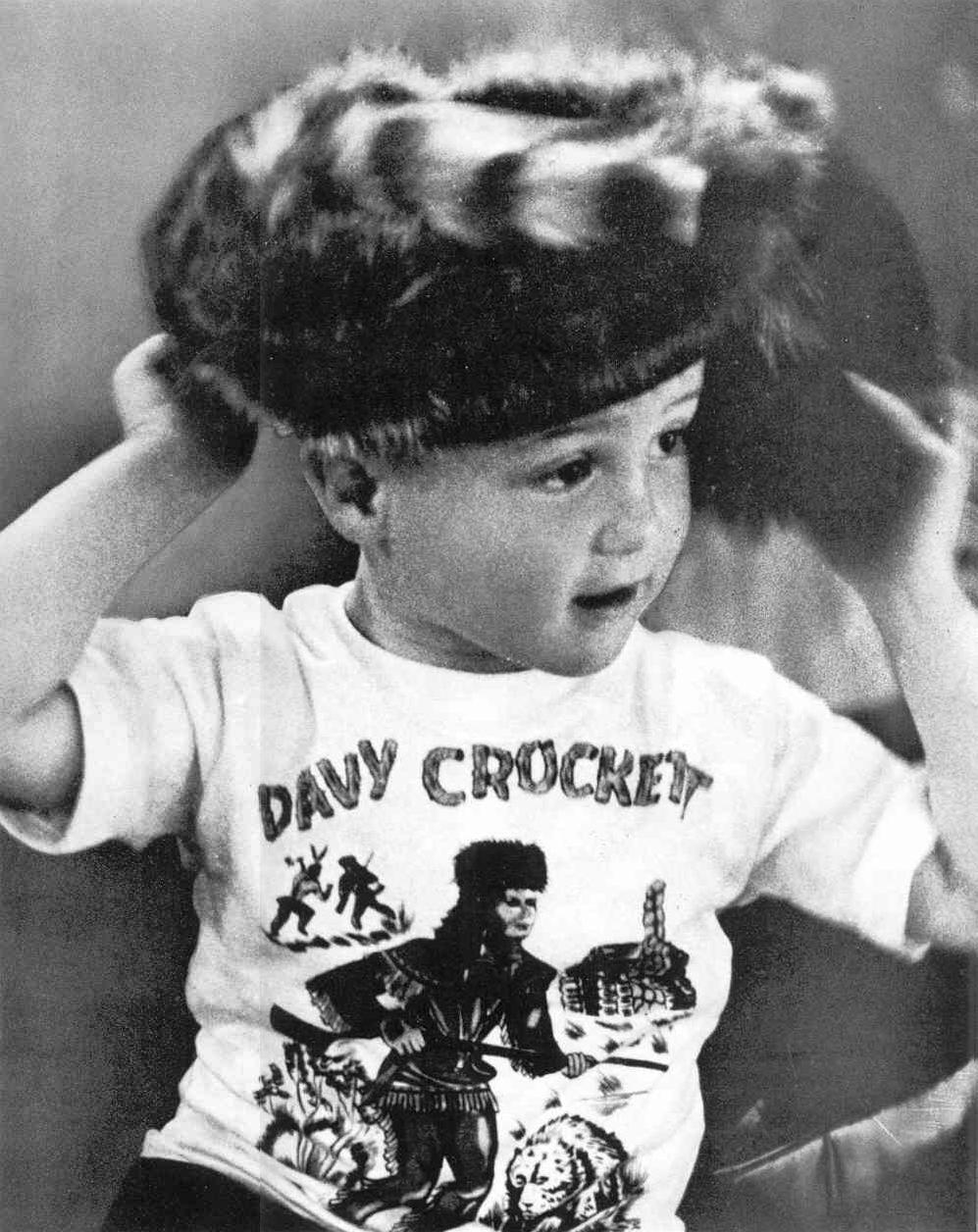
Also extremely popular at
that time was the Disney TV series on Davy Crockett, "King of the Wild
Frontier." Actually the youth revolution
was already well underway as America entered the 1950s.
AND THE VETS HAVE THEIR OWN PARTICULAR FORM OF IDEALISM THE FOLLOW |
|
The Vets did not realize that their own
Christian, free market, patriotic, hard- working, self-sacrificing,
democratic American Middle-Class values had come to themselves through
much trial and tribulation – and were not simply the natural
inclinations of any and all free peoples anywhere. Tragically this
would blind them not only in the raising of their own children, it
would also blind them in their approach to their responsibilities
abroad. Here too, the Vets tended to believe (as an article of some
kind of civic religion) that democracy such as was practiced in the
United States was the natural inclination of people everywhere …
provided that such people were freed from their own local authoritarian
tyrannies (dictators) so as to be allowed to freely take up democratic
ways.
This was not a new idea in America, for
it had been the directing idea of America’s ill-fated involvement in
World War One. It was now once again a persistent idea in America,
making its appearance after World War Two when Americans assessed the
great achievement they themselves had secured with their own civil
program of Middle American democracy. It was natural that America would
want the rest of the world to share in this glory.
All that seem to be needed was for
America to help the world dump dictators, tyrants, indeed anything that
seemed to govern a people through dominating power from above. This
would even include a move against their British and French allies, who
held together their own multi-ethnic global empires, directed not from
local power centers but from London and Paris. This same instinct was
indeed why the Americans had taken such a strong stance against their
Dutch allies – when America supported so strongly the local
independence movement in Indonesia (which interestingly soon resulted
in the Indonesian dictatorship of Sukarno).
Sadly, the Vets would not be easily
shaken from this civic religion, and would pass this on to their Boomer
children, who would pass this on in turn to their children, the
Gen-Xers, and so forth. It is an article of unexamined Humanist faith
that still afflicts America today.
Also: the Vets' sense of corporatism
Another key feature of the strong Vet
Middle-Class culture was the deep trust that the Vet generation placed
in corporate life – to the point of agreeing that all of life would
function better using rational or scientific corporate-style processes
(programs ... and more programs as the way to go at life). Although the
Vets presumed themselves to be highly Christian (church attendance was
at an all-time high), the Vet approach to God and Christ tended to run
along the idea that God helps those who help themselves. Though Vets
held a deep personal trust in God's love and grace, when it came to
social trust, Vets were great believers in their own rational
organizing and management of life.
The Vets sincerely believed that although
Americas wartime victory was undoubtedly the result of God's great
help, the Vets saw that help as having been transacted through the
massive military-industrial complex which organized millions of
Americans into an effective fighting machine. The Vets' loyalties to
such organizational logic were virtually unshakeable.
The Vet tendency toward corporatism
showed up in the way they were great joiners: Masons, Lions Club,
Kiwanis, church fellowship groups, bridge clubs, country clubs, etc.
They also tended to go to work for companies and corporations with the
intention of remaining at that job until they went into retirement at a
late age. They also stayed married to their spouses … for a lifetime –
in plenty and in want. Their highly structured world was safe, stable
and even unshakeable.
That would not be the case for their
Boomer children. And thus the Vets would be greatly perplexed (even
greatly upset) when they could not figure out why their Boomer children
did not just naturally take up the social habits the Boomers had grown
up with under Vet parenting. A quite different Boomer social dynamic
would reveal itself to the eyes of the uncomprehending Vets when the
Boomers began finally to enter their first years of adulthood in the
mid-1960s. It seemed at that point that the Boomers stood against
almost every social value that the Vets stood for!
THE "SILENT" OR IN-BETWEEN GENERATION |
|
Interestingly, between the Vets and their
Boomer offspring stood an in-between group, the "Silents." They were
young Americans who were born just prior or even during the war and who
reached their teens in the 1950s. They were aware of the Cold War
raging around them. But they too had their own youth culture of
basically rock and roll and sock hops at the local high school. But
unlike the Boomers, they were not rebels by instinct, having grown up
before the anti-authoritarian lessons could dig deeply into their
mindsets. They were basically good kids, rather patriotic, though more
attuned to what was happening at the football games or on TV
(especially the American Bandstand where they could observe and learn
the latest dance step, such as the Stroll or the Peppermint Twist!).
Most would go on to work right after high
school – like the older generation of Vets. Others (actually not many)
headed on to college, though college did not yet qualify as the great
social status project, such as it would eventually become during the
1960s. The Silents would also be the group that in finishing college
would answer President Kennedy's patriotic call to take the American
way of life abroad through Peace Corps service in the villages of the
Third World countries (Asia, Africa and Latin America).
|
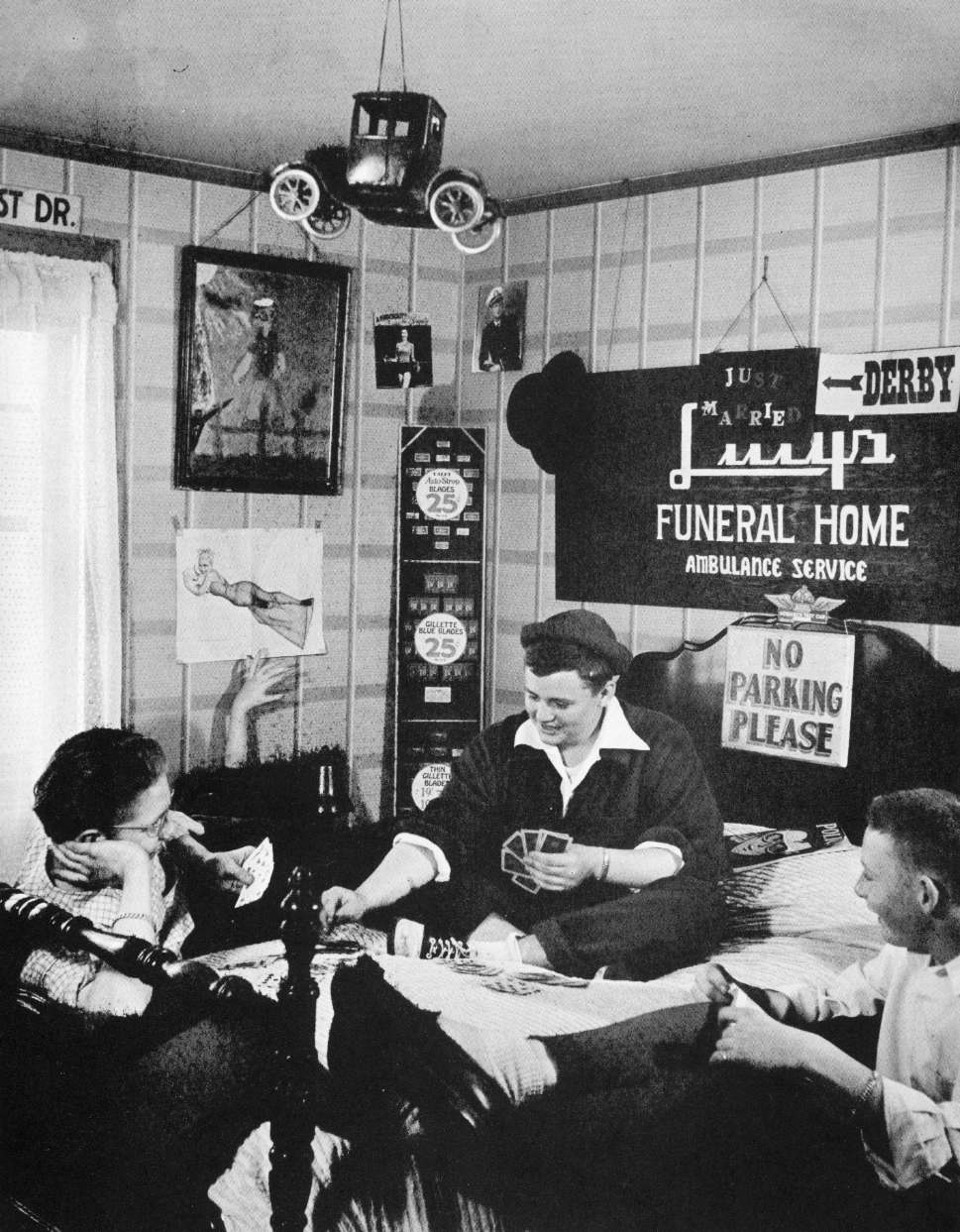
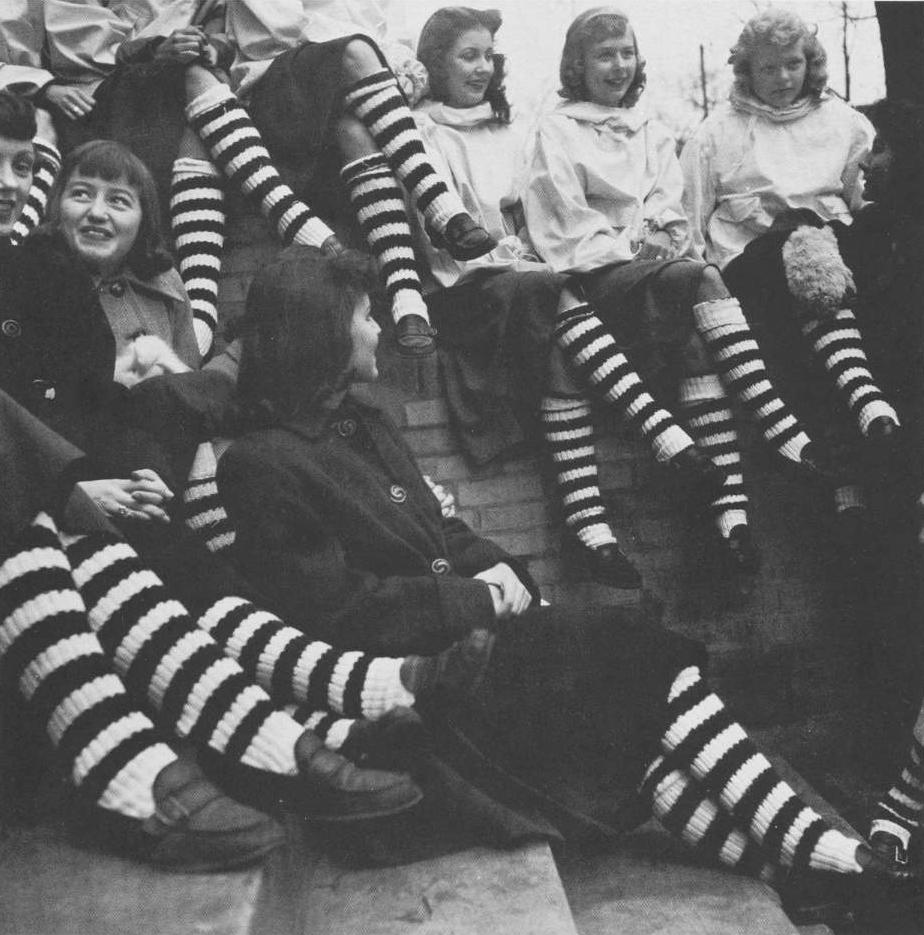
Striped football socks
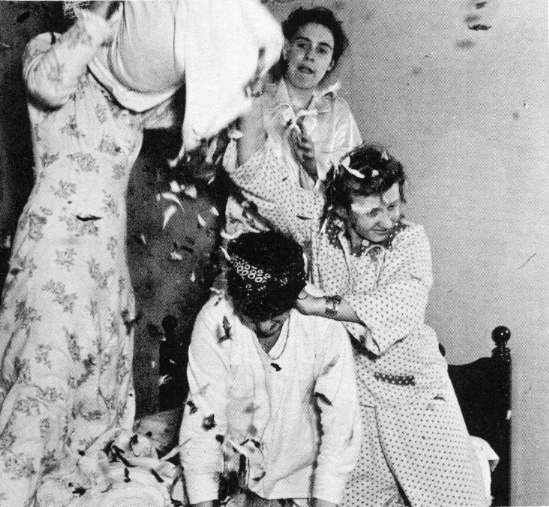 Girl's slumber party in Indianapolis – 1943
Girl's slumber party in Indianapolis – 1943
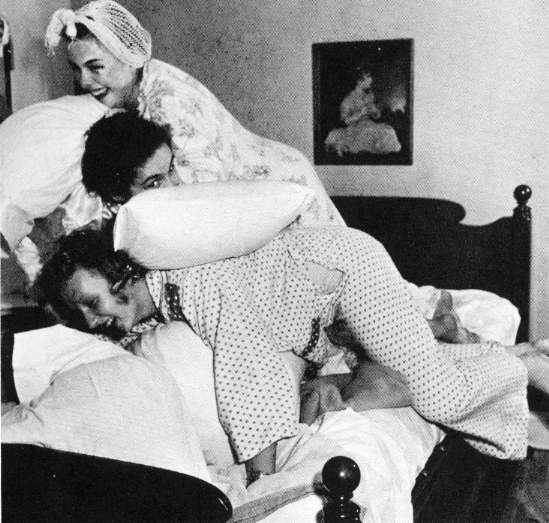 Girl's slumber party in Indianapolis
Girl's slumber party in Indianapolis
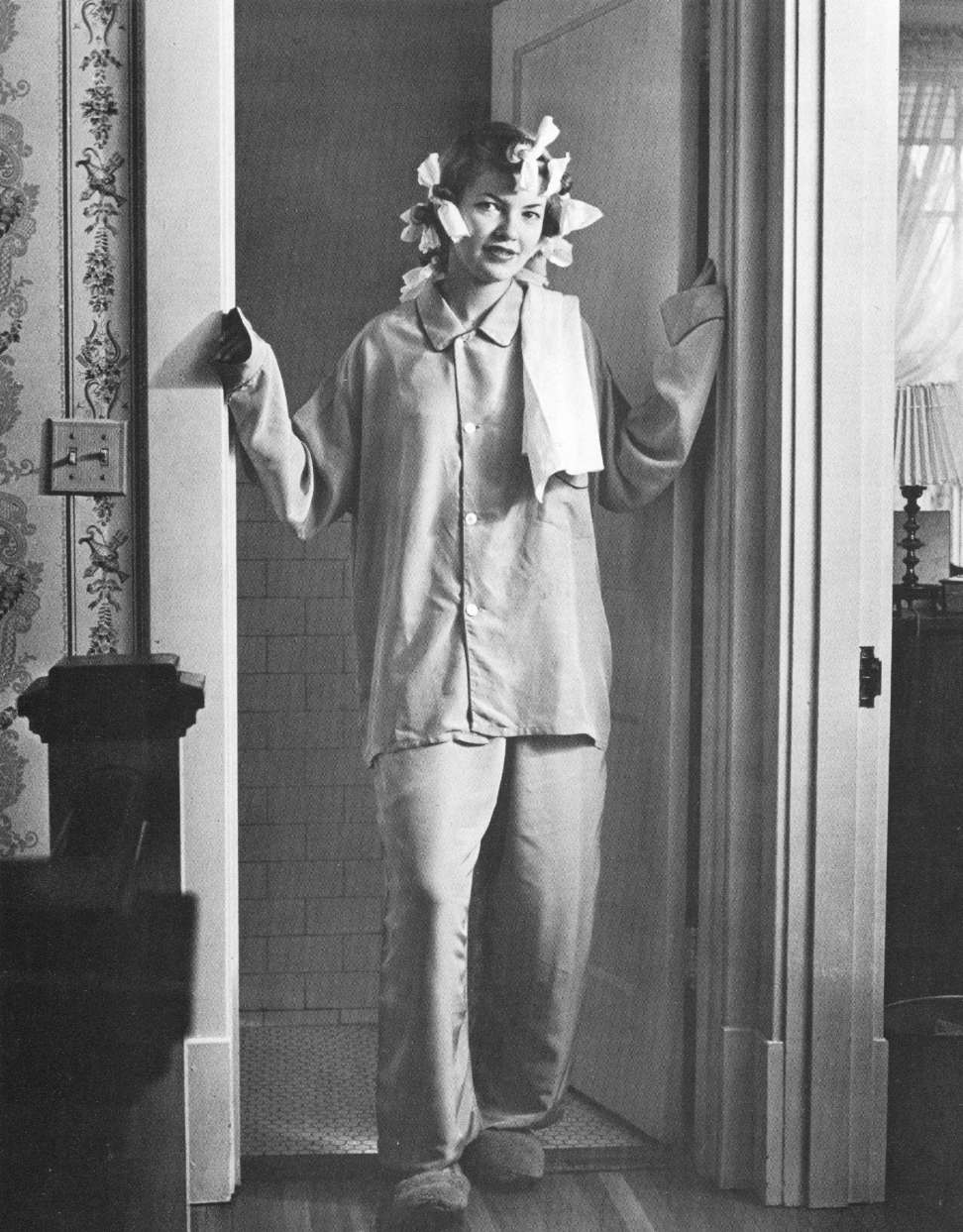 Ready for the party in Webster
Groves, Missouri
Ready for the party in Webster
Groves, Missouri
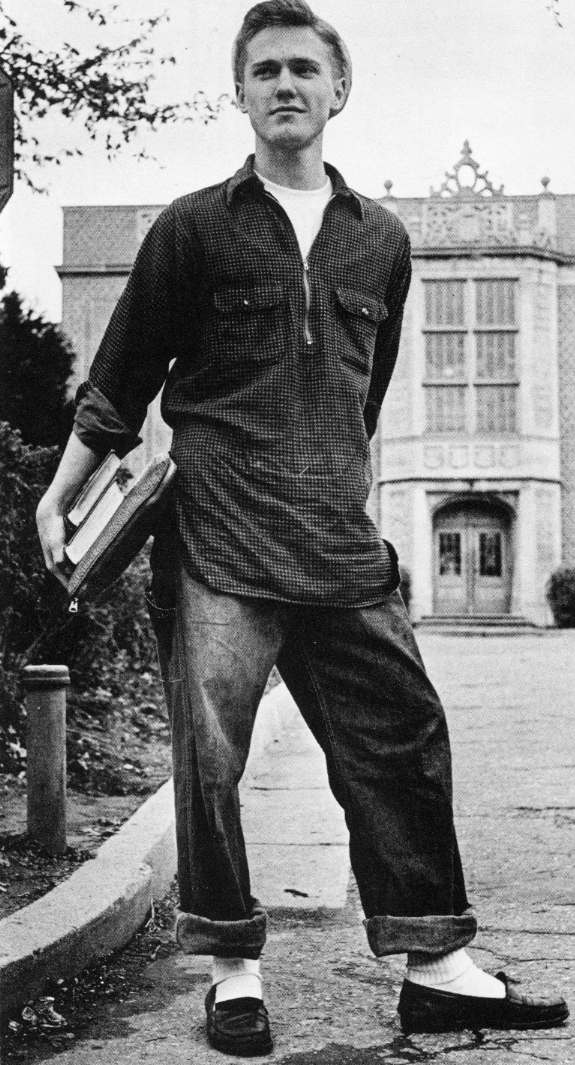 Regulation campus wear for
the young man
Regulation campus wear for
the young man
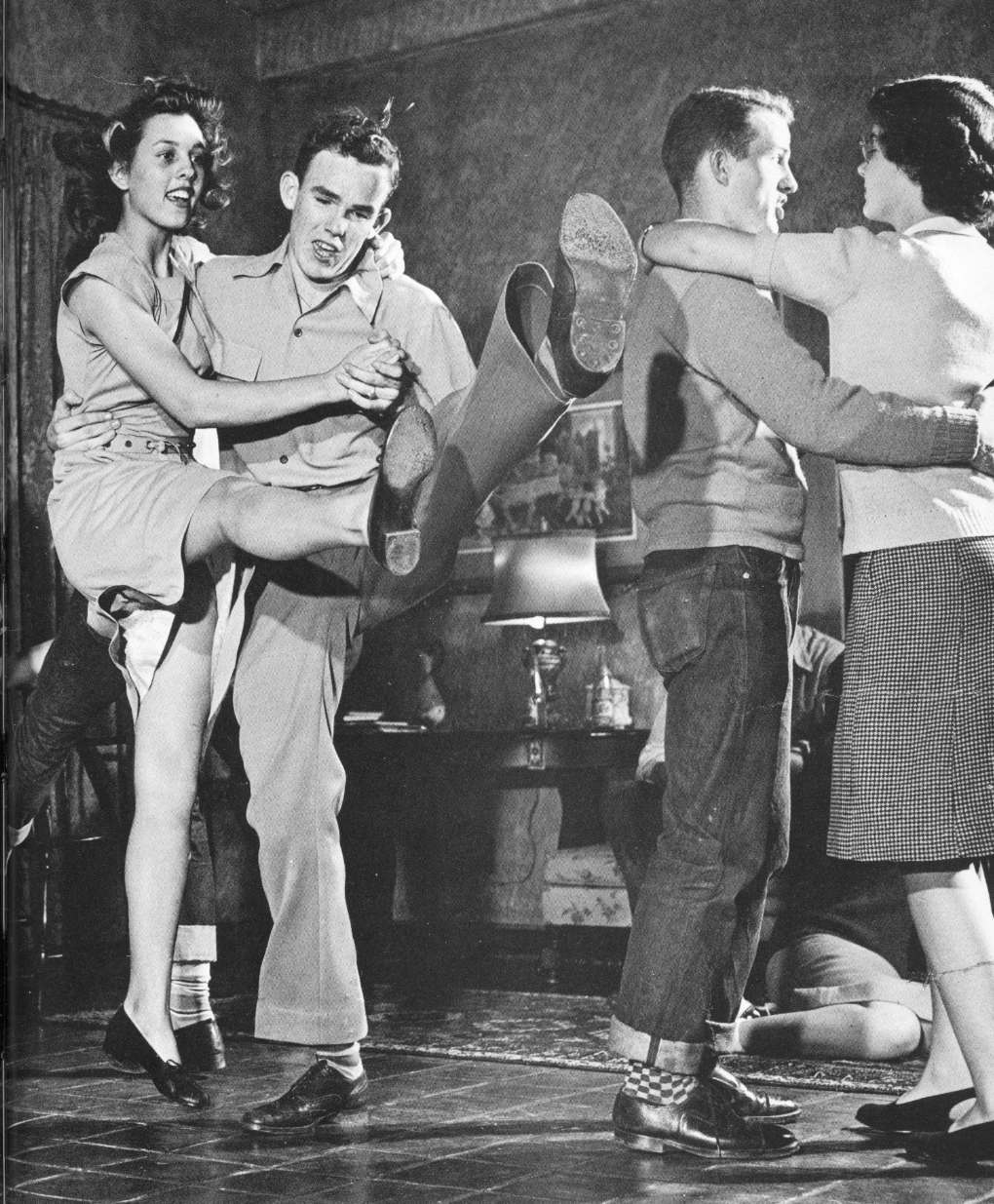 Doing the Lindy in Portersville,
California
Doing the Lindy in Portersville,
California
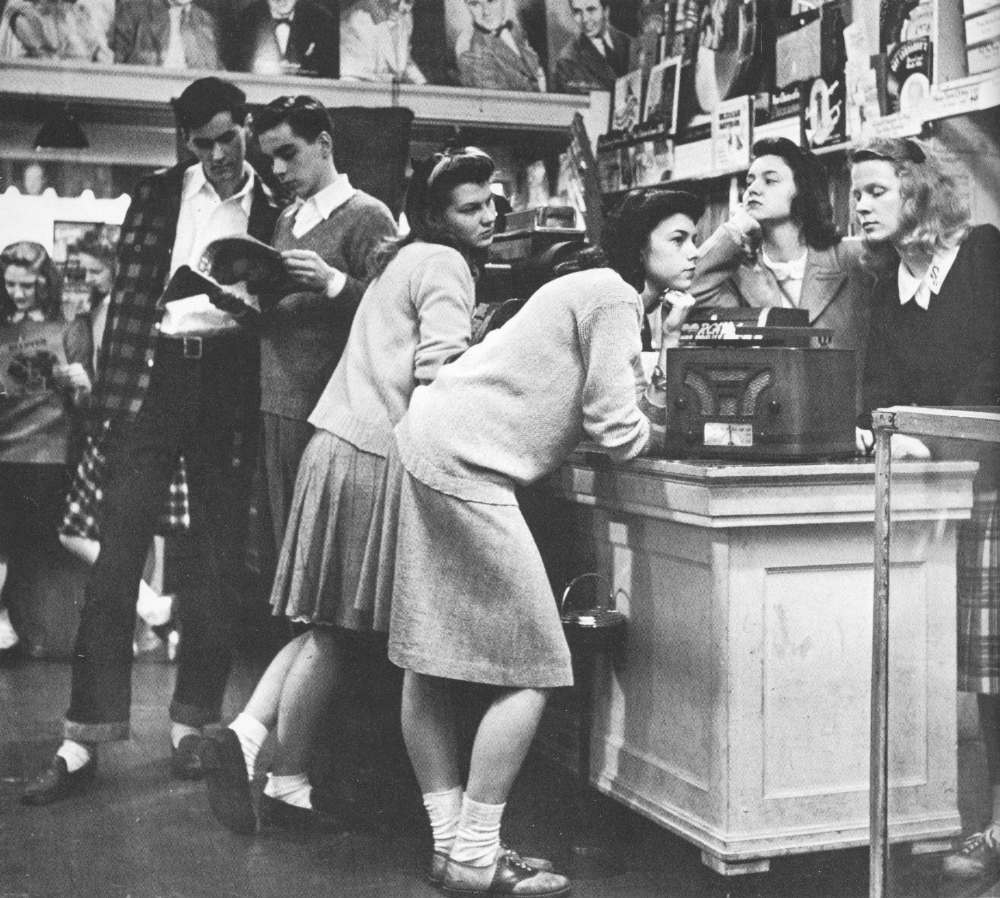
Listening to records at Lemcke's
in Webster Groves, Missouri
As with all youth, the "Silents" had their own idols to worship
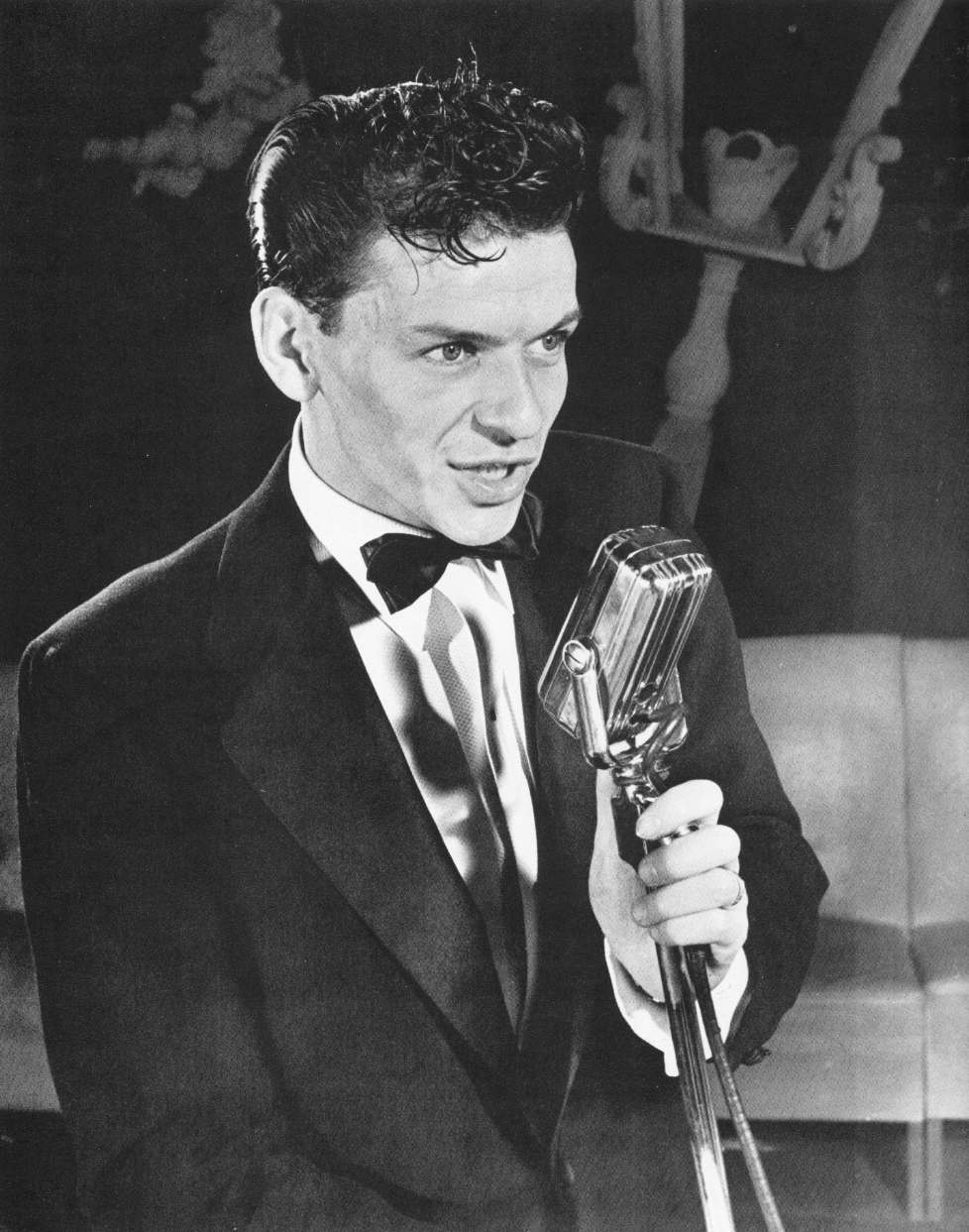 Frank Sinatra croons a tune
to a wildly adoring female audience
Frank Sinatra croons a tune
to a wildly adoring female audience
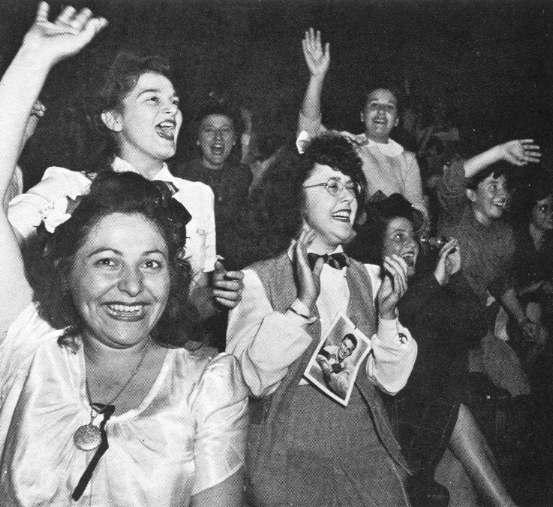 Sinatra's enthusiastic female
audience
Sinatra's enthusiastic female
audience
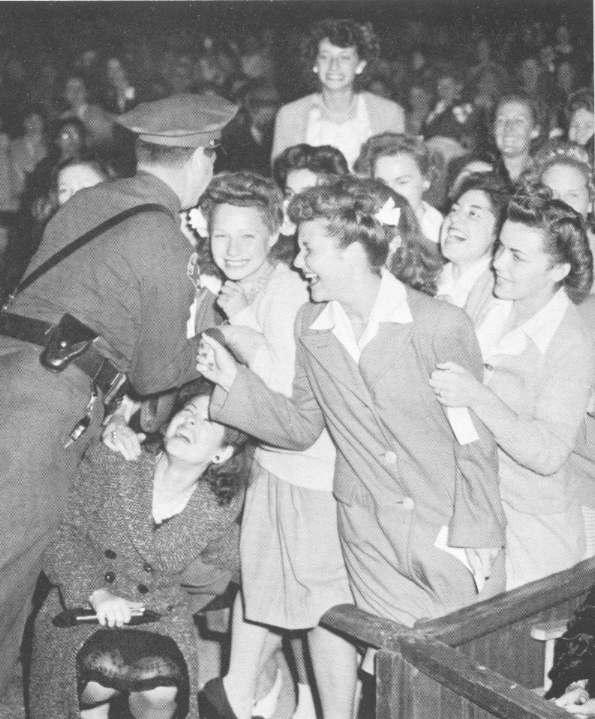 Trying to restrain Sinatra's
female fans
Trying to restrain Sinatra's
female fans
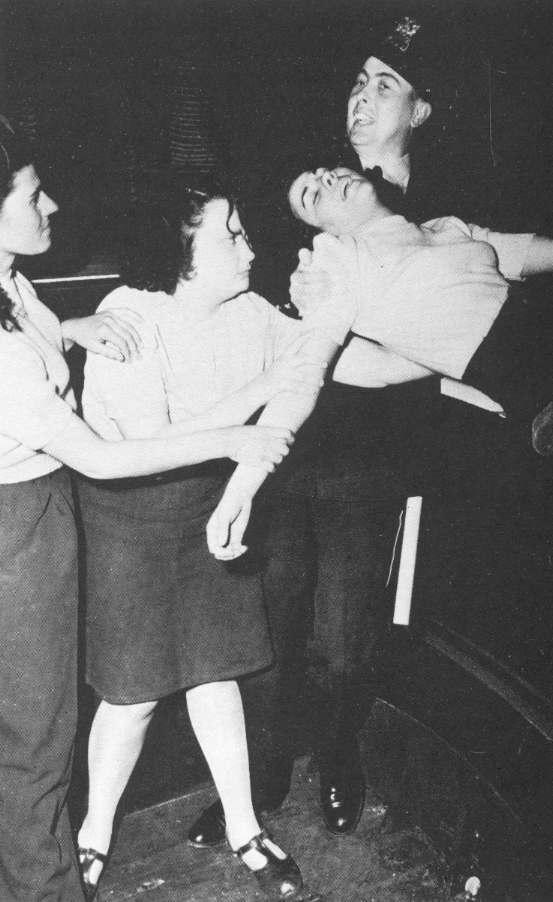 Carrying out one of Sinatra's
raptured fans
Carrying out one of Sinatra's
raptured fans
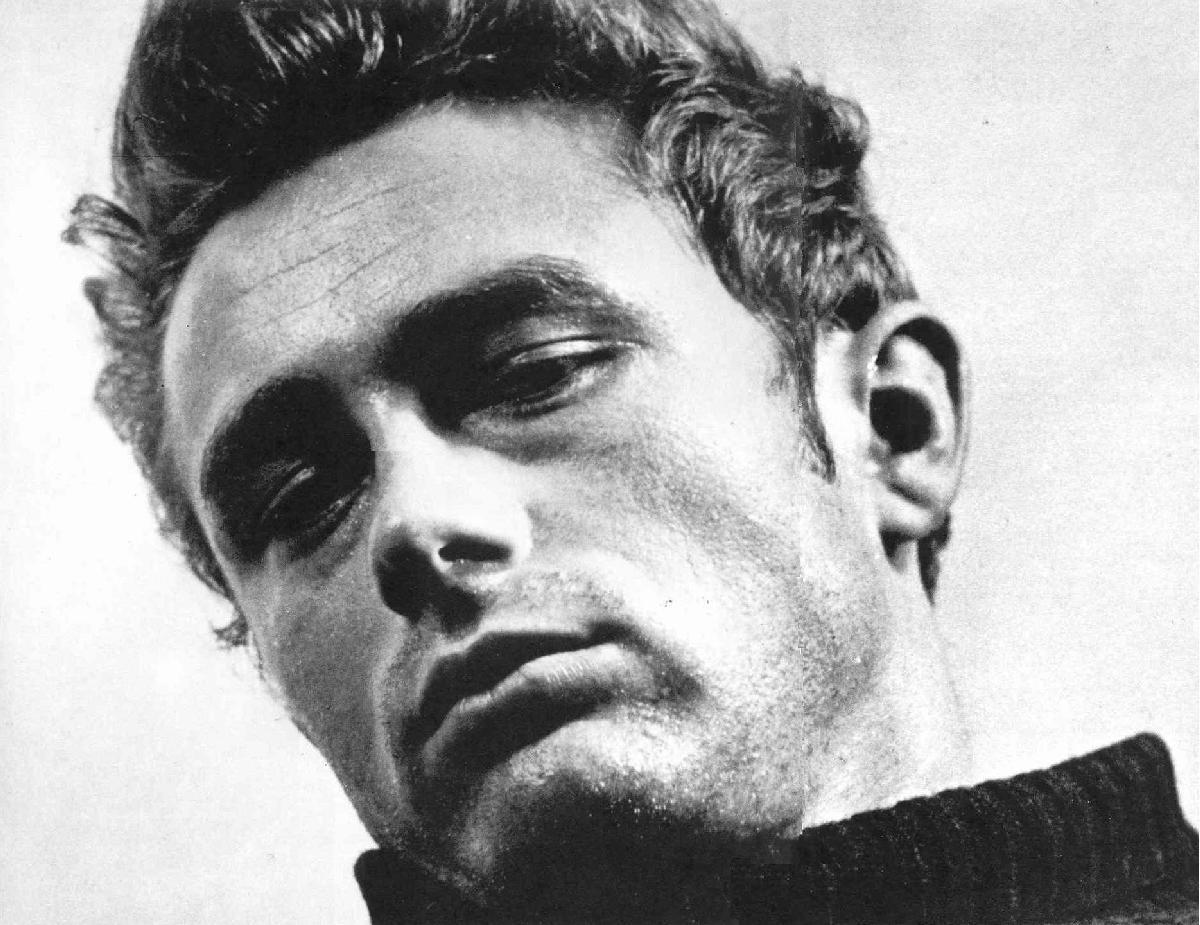 Another teen heartthrob was
the actor James Dean
Another teen heartthrob was
the actor James Dean
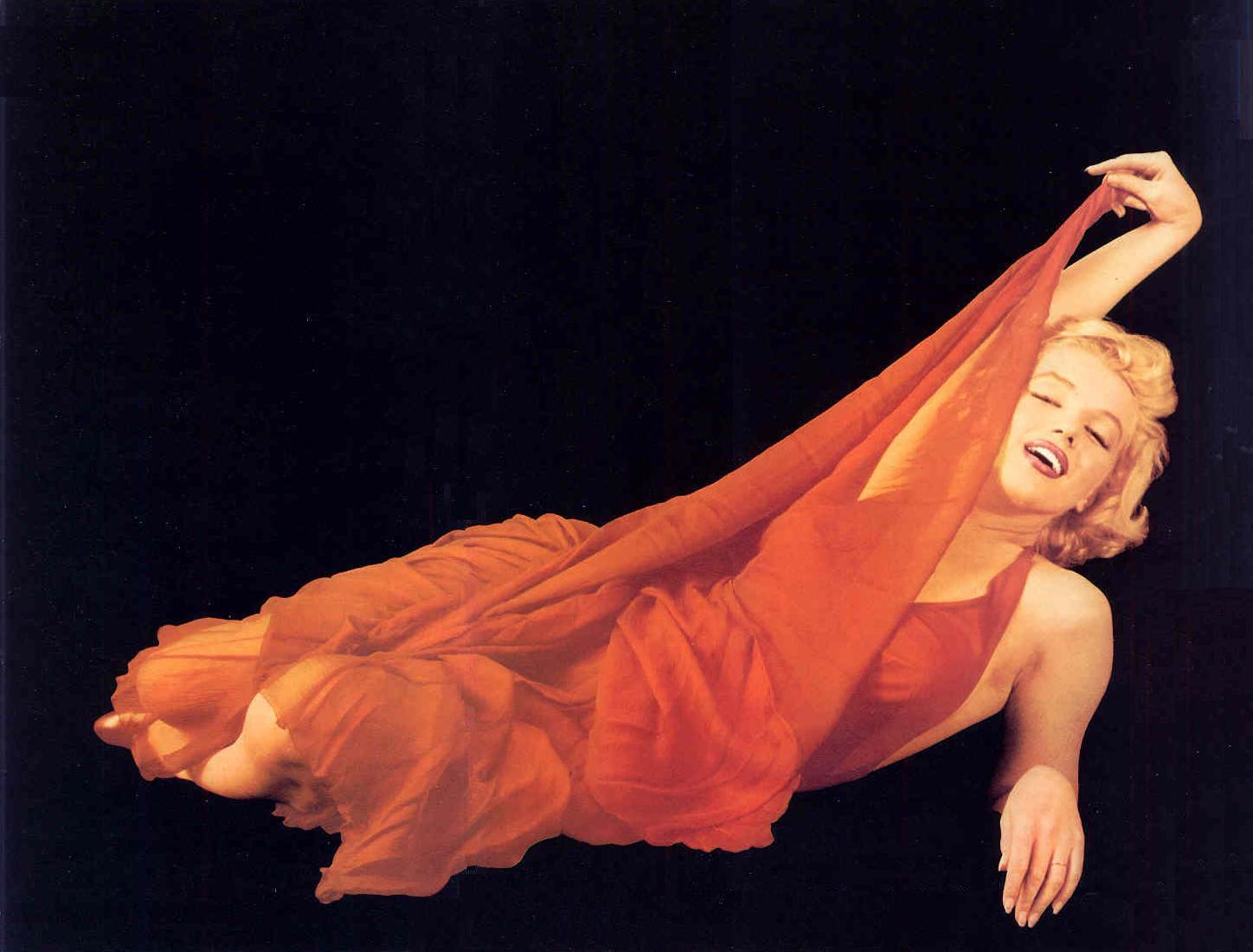
And for the guys, Marilyn
Monroe
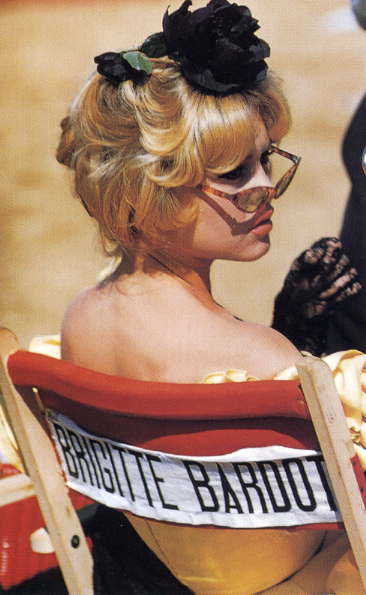 ... and the French actress
Brigitte Bardot
And to the distress of the older Vet generation ... the "Silents" loved to "jitterbug" to the likes of Bill Haley and the Comets!
... and the French actress
Brigitte Bardot
And to the distress of the older Vet generation ... the "Silents" loved to "jitterbug" to the likes of Bill Haley and the Comets!
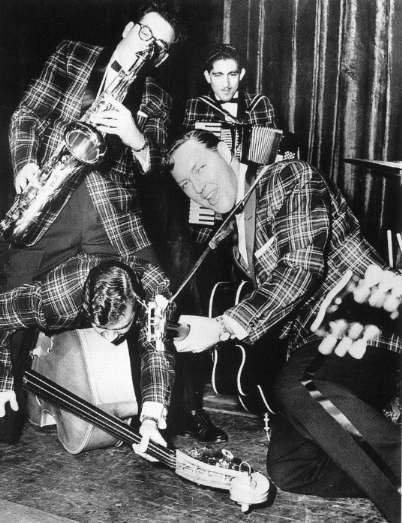 Bill Haley and the Comets
- launching rock and roll music with their 1955 hit, "Rock around the Clock"
Bill Haley and the Comets
- launching rock and roll music with their 1955 hit, "Rock around the Clock"
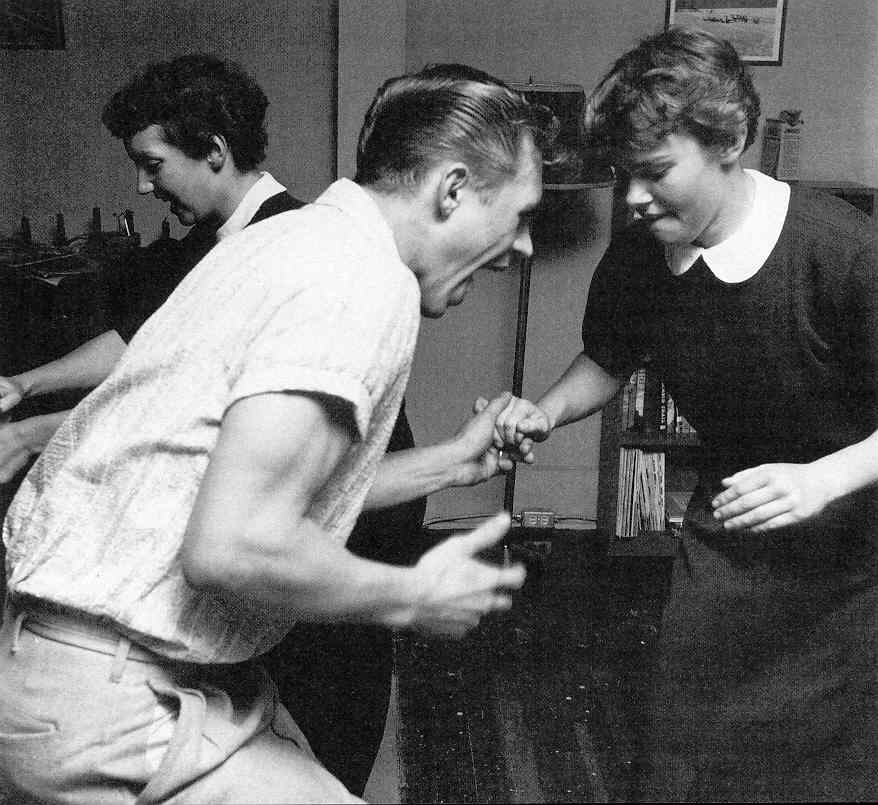
Jitterbugging -
1950s
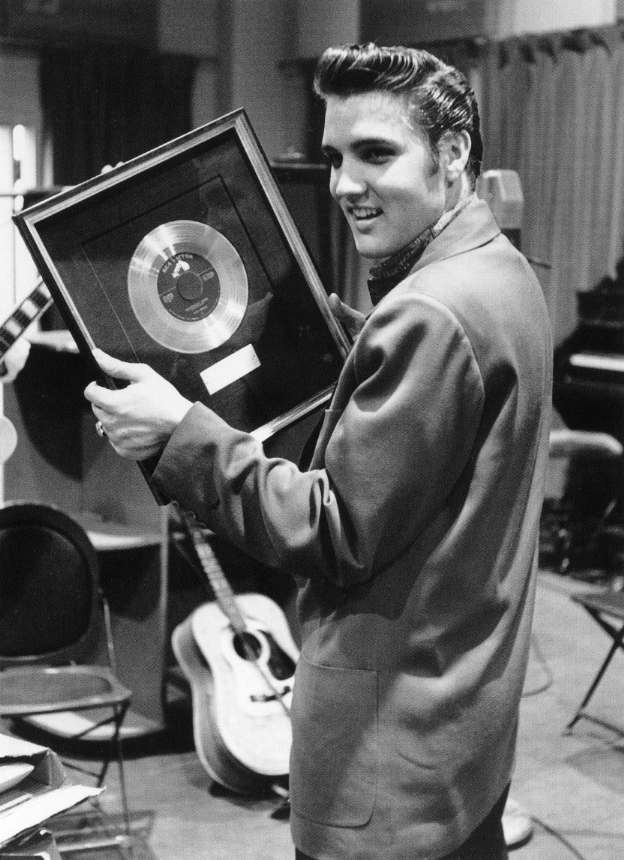 Elvis Pressley with his gold
record award for "Heartbreak Hotel" – 1956
Elvis Pressley with his gold
record award for "Heartbreak Hotel" – 1956
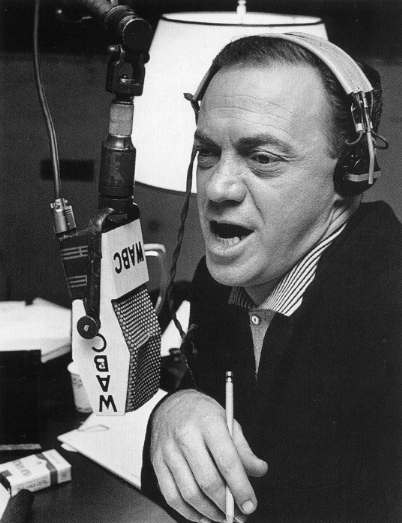 Alan Freed – founder of the
rock and roll DJ style – 1959
Alan Freed – founder of the
rock and roll DJ style – 1959
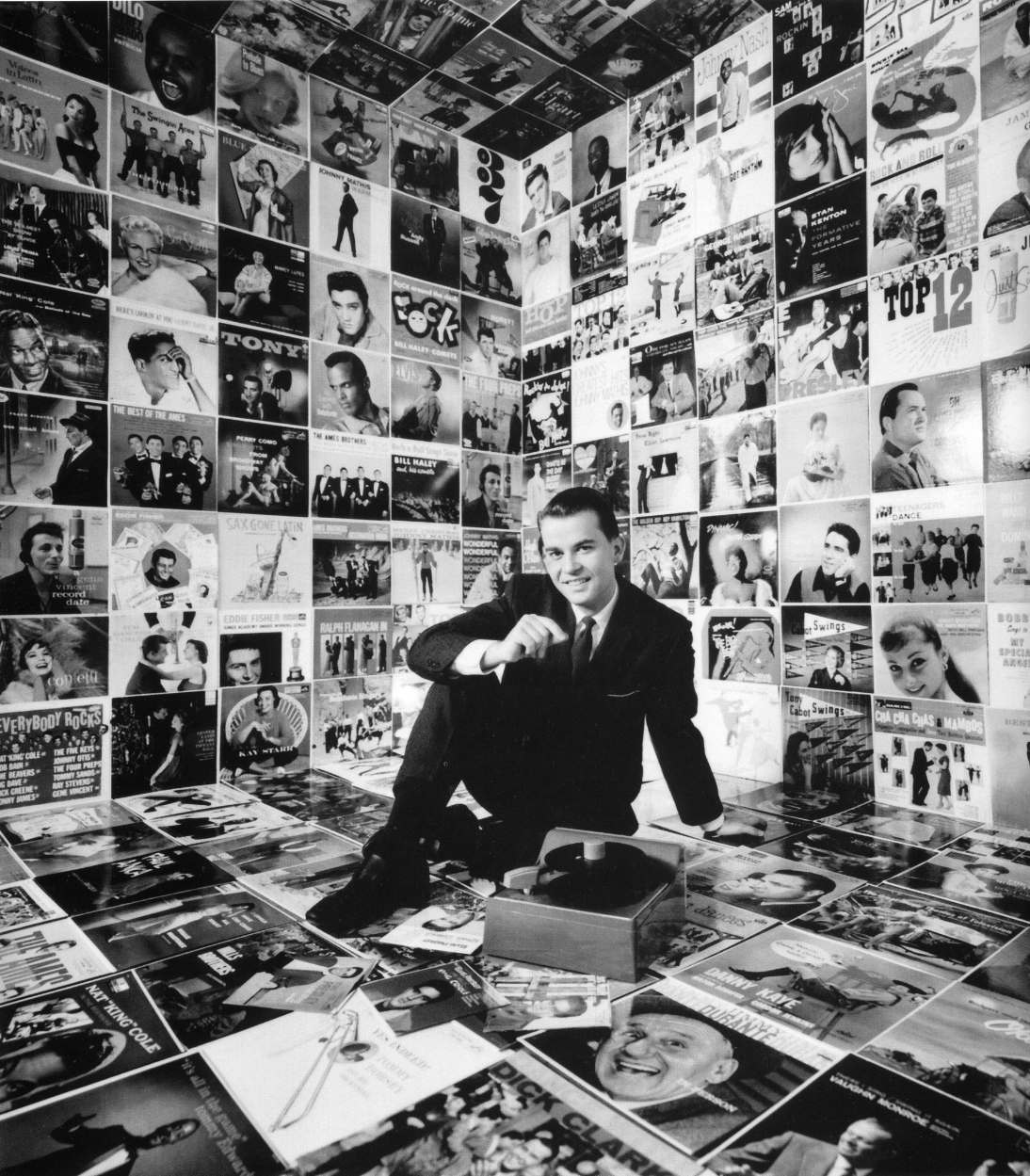 Dick Clark (age 28) taught
American youth Rock and Roll dance styles with his nationally broadcast
TV show, American Bandstand – launched in 1957
Dick Clark (age 28) taught
American youth Rock and Roll dance styles with his nationally broadcast
TV show, American Bandstand – launched in 1957
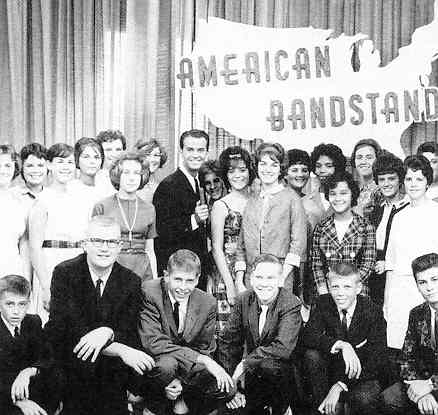 Dick Clark and the American
Bandstand – late 1950s (featuring talented local "South Phillie" youth).
Dick Clark and the American
Bandstand – late 1950s (featuring talented local "South Phillie" youth).
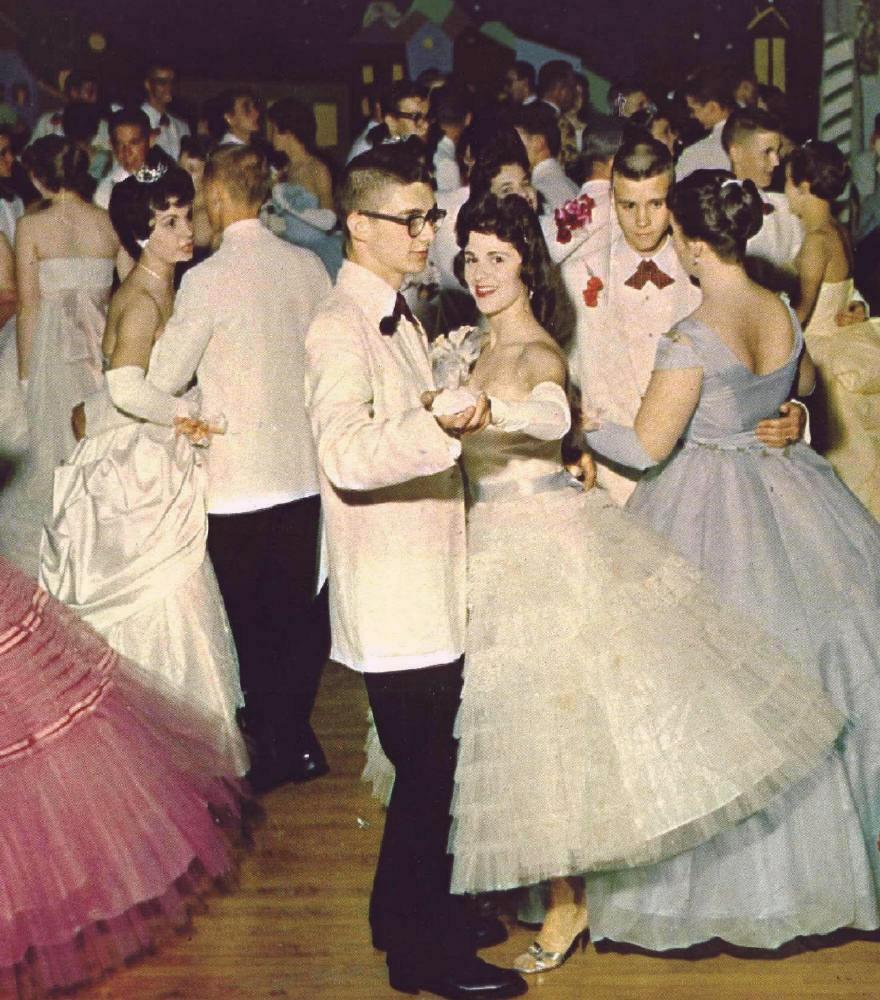 At the Collinsville High
School Senior Prom with Roseann – 1959
At the Collinsville High
School Senior Prom with Roseann – 1959
Miles
Hodges
ALSO ... TRAGICALLY, AMERICAN BLACKS DO NOT SHARE IN
AMERICA'S NEW MIDDLE CLASS CULTURE – AND BEGIN TO PROTEST |
|
About one in ten Americans were classed as being
Negro or Colored, most living in the American South – and those in the
North living largely in isolated Black sections of America's industrial
cities. No real progress had been made to open the doors of Middle
America to the Blacks, and thus Blacks went about their lives largely
unnoticed within the larger American culture and its heated issues of
the day. True, some notice had come to the issue of the Blacks in
American life because of the great skill and bravery of the Tuskegee
Airmen during World War Two in their service as pilots flying the
fighter planes protecting American bombers over Italy, and the enormous
talent of Jackie Robinson, who in 1947 broke the color bar when he was
brought on the Brooklyn Dodgers' team as its first baseman. But beyond
this, little progress had been made to advance the social position of
the Blacks in their own homeland. But that would begin to change as
America headed into the second half of the 1950s.
Rosa Parks and the Montgomery bus boycott
National attention came to be focused on
a massive bus boycott by Blacks in Montgomery, Alabama – which started
when in December of 1955 an exhausted Black seamstress, Rosa Parks,
refused to give up her seat for a White in a crowded bus (as was
expected of Blacks, even those sitting in the Colored section) and was
arrested. But the Montgomery chapter of the National Association for
the Advancement of Colored People (NAACP) decided to fight the case.
Parks was secretary of the Montgomery chapter of the NAACP, which
included also within its local leadership a young pastor who had
recently taken a Montgomery pulpit, the Rev. Dr. Martin Luther King,
Jr. – who would come to head up a boycott of the town's buses. Not
only would the NAACP encourage Blacks to avoid the use of the town's
buses,4 it would fight
the $14 fine – as far up the judicial appeals ladder as the case would
go – in opposition to the segregation laws designed to keep Blacks in
their place.
Blacks cooperated with the call for a bus
boycott by refusing to board Montgomery’s buses, requiring them to
walk to their place of employment, or be picked up personally by their
employers. National newspapers began to cover the boycott as it dragged
on for months. But attention became increasingly focused on a new
Federal court case, Browder v. Gayle (Parks' case was tied up in the
Alabama state court system), challenging Montgomery’s segregation laws,
which made its way to the U.S. Supreme Court, which in November of 1956
supported the District Court’s decision that these segregation laws
were in violation of the Fourteenth Amendment, and thus were
unconstitutional.5
4The boycott lasted over a year, until the struggling bus company finally put aside the seating restriction.
5"No
State shall make or enforce any law which shall abridge the privileges
or immunities of citizens of the United States; nor shall any State
deprive any person of life, liberty, or property, without due process
of law; nor deny to any person within its jurisdiction the equal
protection of the laws."
This 1956 decision fell closely in line with the earlier 1954 Supreme
Court decision in the case of Brown v. Board of Education of Topeka,
Kansas in which the Court decided that school segregation was in
violation of the Fourteenth Amendment and thus unconstitutional.
The Montgomery Alabama bus
boycott (1955 – 1956)
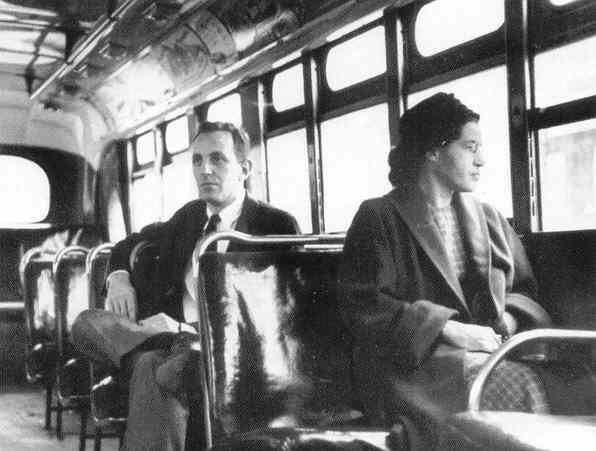
Rosa Parks – whose refusal
to give up her seat to a White started the Montgomery bus boycott
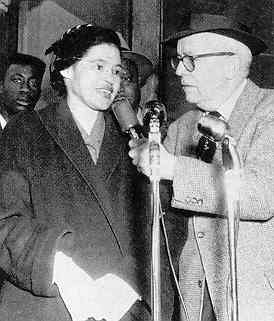
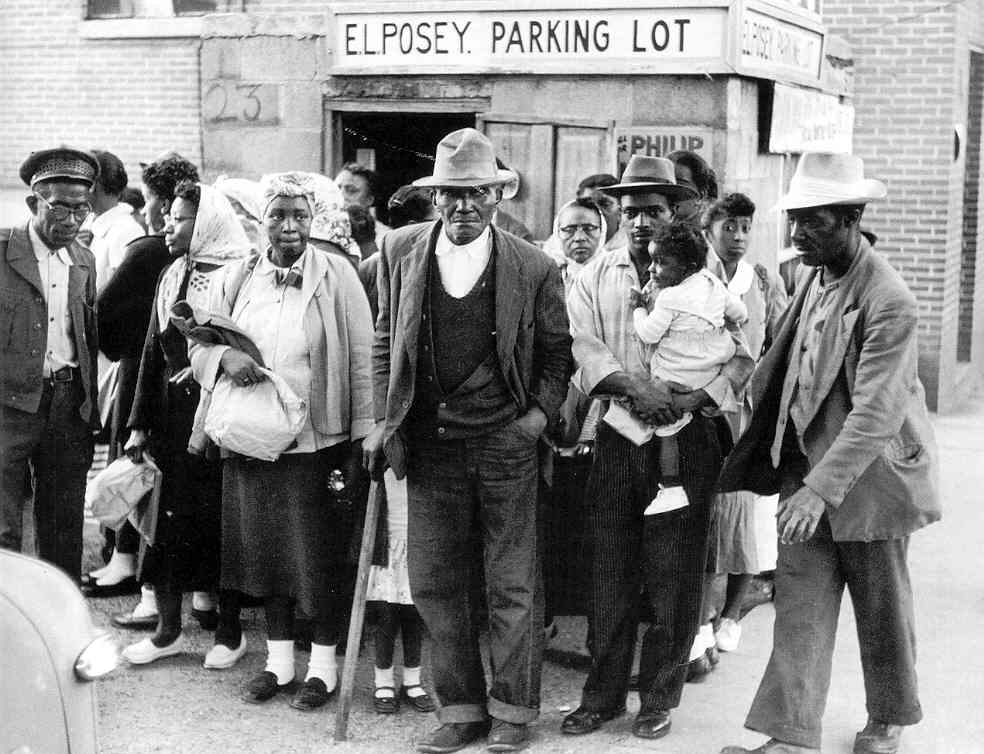
Blacks at a transportation
pickup point during the Montgomery bus boycott – 1955-1956
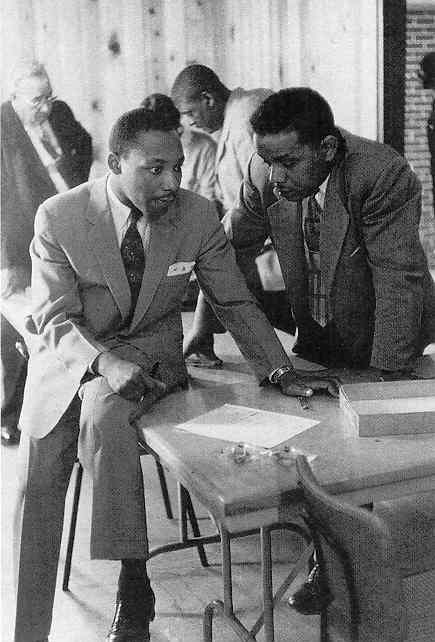
Rev. Dr. Martin Luther King,
Jr., directing the Montgomery bus boycott
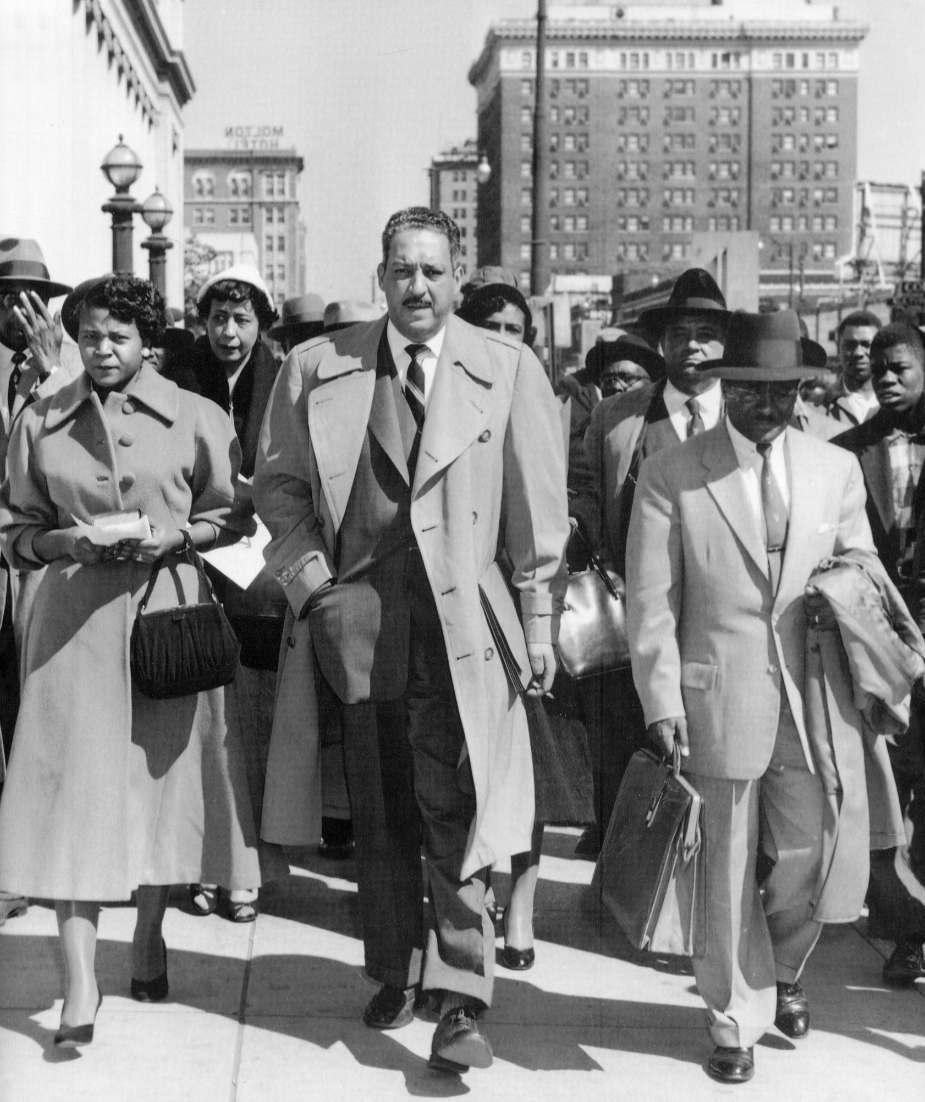
Thurgood Marshall with Autherine
Lucy, who in 1956 was prevented from entering the University of Alabama, heading
to the U.S. District Court in Birmingham to contest the action. He won the case in court
but the University expelled her anyway
|
The battle over Little Rock's school integration
Thus it was that the board of the Little Rock,
Arkansas, school district decided to admit Black students to White
schools on a gradual basis beginning with the 1957 school year. But
Arkansas Governor Orville Faubus decided to take the popular (with
Whites anyway) stand against this action by calling out the National
Guard to block the entrance of a small number (nine) of Blacks
designated to be admitted to the formerly all-White Central High
School. Angry crowds joined the National Guard ... much to the chagrin
of both the school board and the city's mayor, who called on President
Eisenhower for help. After trying but failing to get Faubus to back
down, Eisenhower responded by placing the Arkansas troops under federal
command, and sending members of the 101st Airborne division to Little
Rock to protect the nine Black students.
The school year was nonetheless a rough
one for the nine Black students. And the issue was not yet over,
because as the next school year approached, Faubus decided to close the
public schools and re-open them as private schools operated by newly
created educational foundations. Looking for public support, he put the
matter before the Arkansas voters, who approved the new policy. But the
Federal Courts blocked his policy, and thus Faubus moved to close
Little Rock's four high schools, which remained closed for the rest of
that 1958-1959 school year. Blacks were unfairly blamed for this sad
development by angry Whites, increasing the racial tensions in Little
Rock considerably. However the next year (1959) the schools reopened,
although with racial tensions still running high.
|
The forced integration of
the Little Rock Arkansas High School (September 1957)
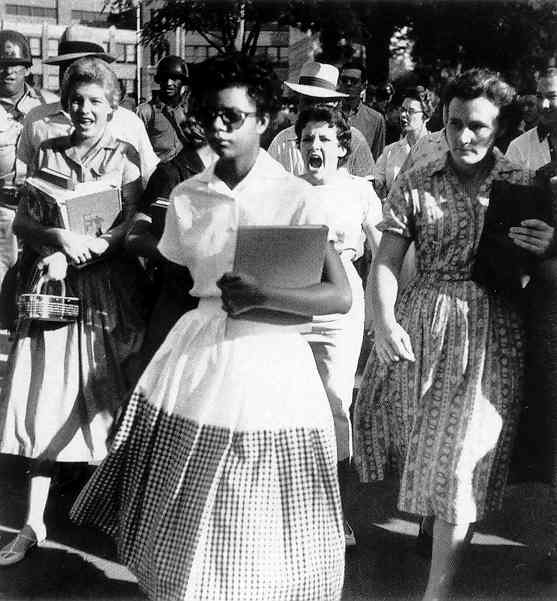
Elizabeth Eckford being followed
by angry Whites as she enters Little Rock,
Arkansas, Central High School – September 1957
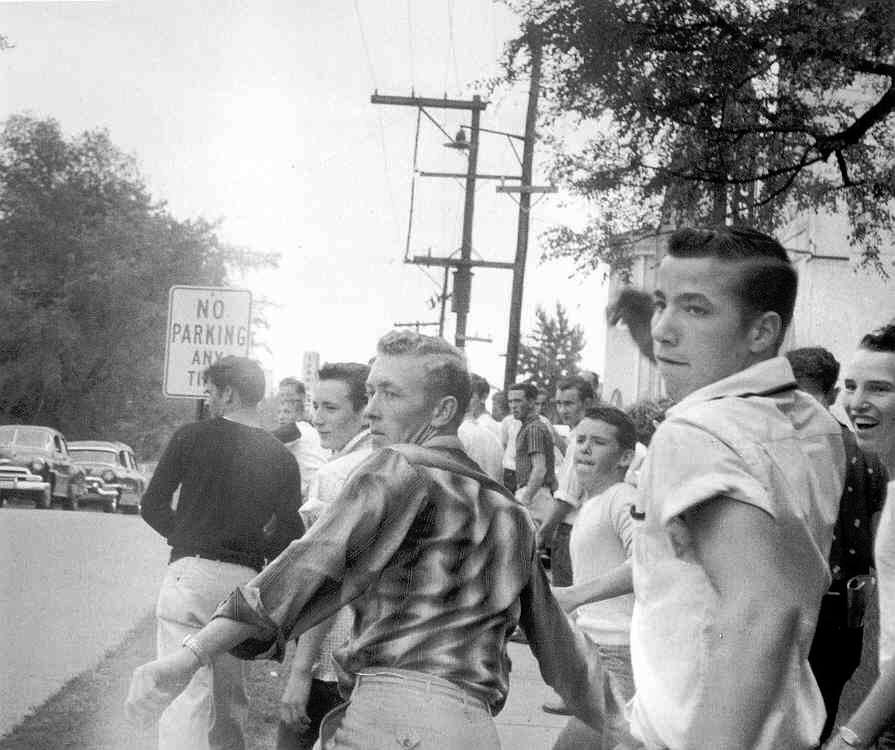
Angry Whites throwing stones
in Little Rock, Arkansas – 1957
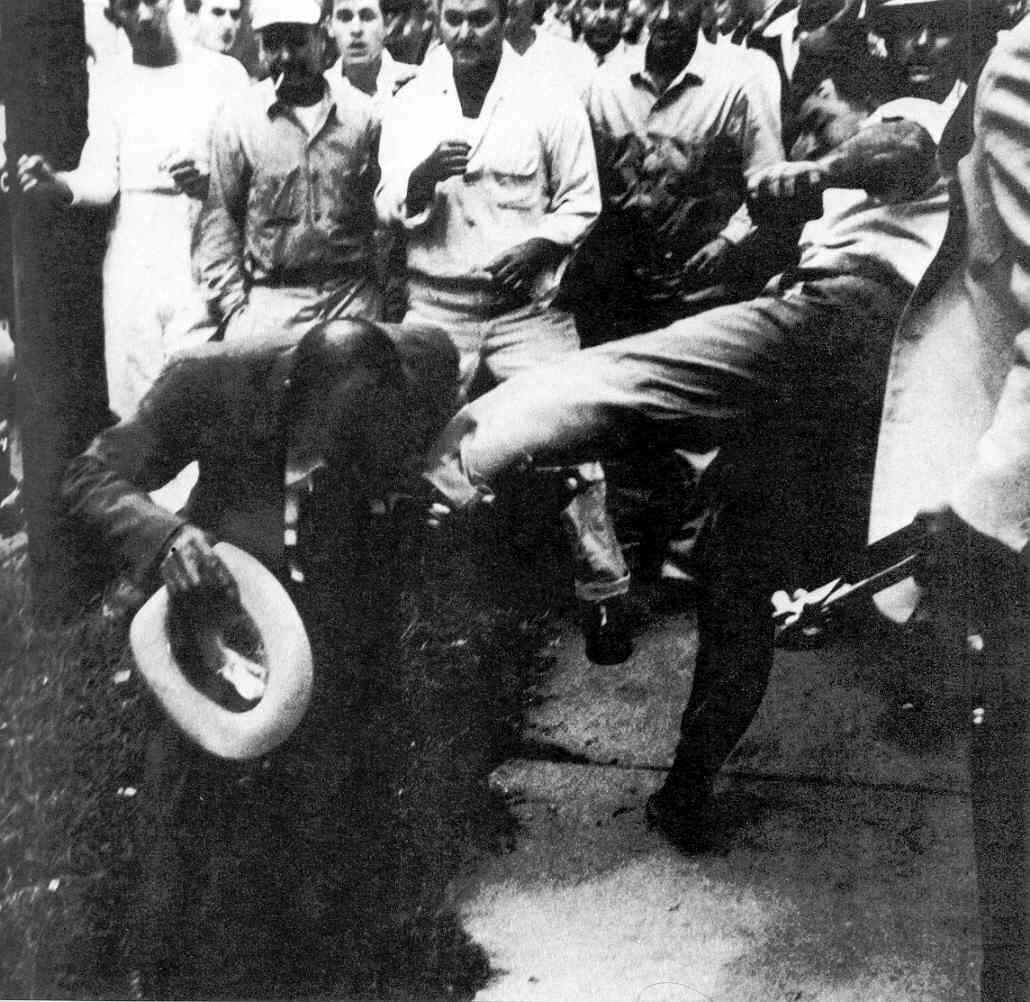
Racial violence flares in
Little Rock
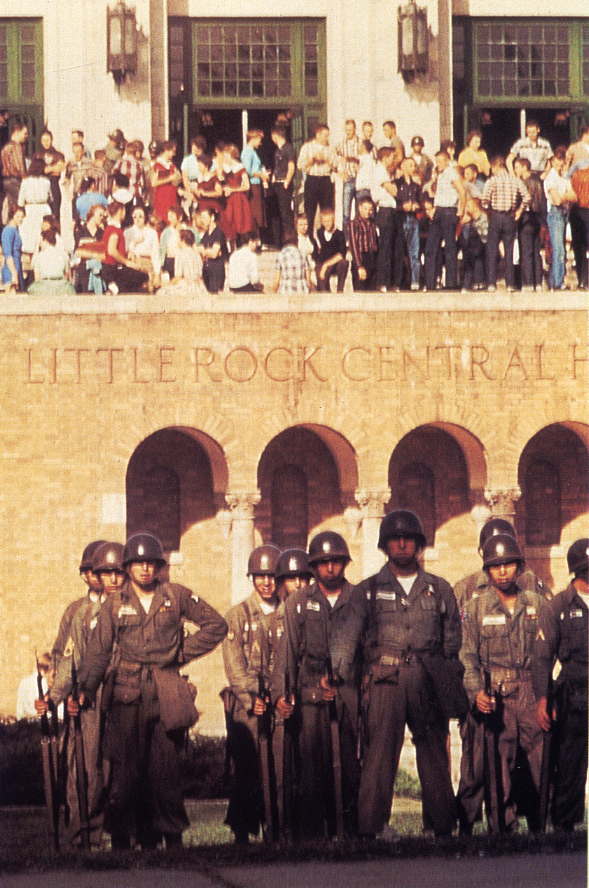
101st Airborne in Little
Rock mobilized by Eisenhower to protect Blacks entering
Central High School – September 1957
HAPPILY, IT'S ALSO A TIME OF SOME "FIRSTS" |
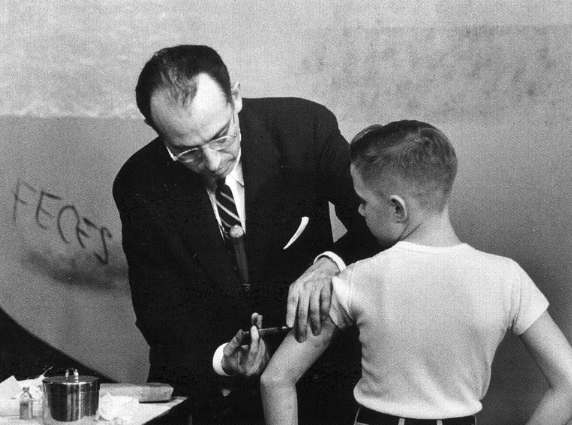
Dr. Jonas Salk injecting
his vaccine against polio – April 1955

Go on to the next section: Developments Abroad
 Miles
H. Hodges Miles
H. Hodges
| | | | | |


 Tensions between "Middle America" and
Tensions between "Middle America" and McCarthy is finally brought down
McCarthy is finally brought down
 Middle America settles in ... quite
Middle America settles in ... quite But a "Boomer" youth culture quite
But a "Boomer" youth culture quite And the Vets have their own particular
And the Vets have their own particular The "Silent" or in-between generation
The "Silent" or in-between generation
 Tragically, Black America does not share
Tragically, Black America does not share Happily, it's also a time for some "firsts"
Happily, it's also a time for some "firsts"






























































































